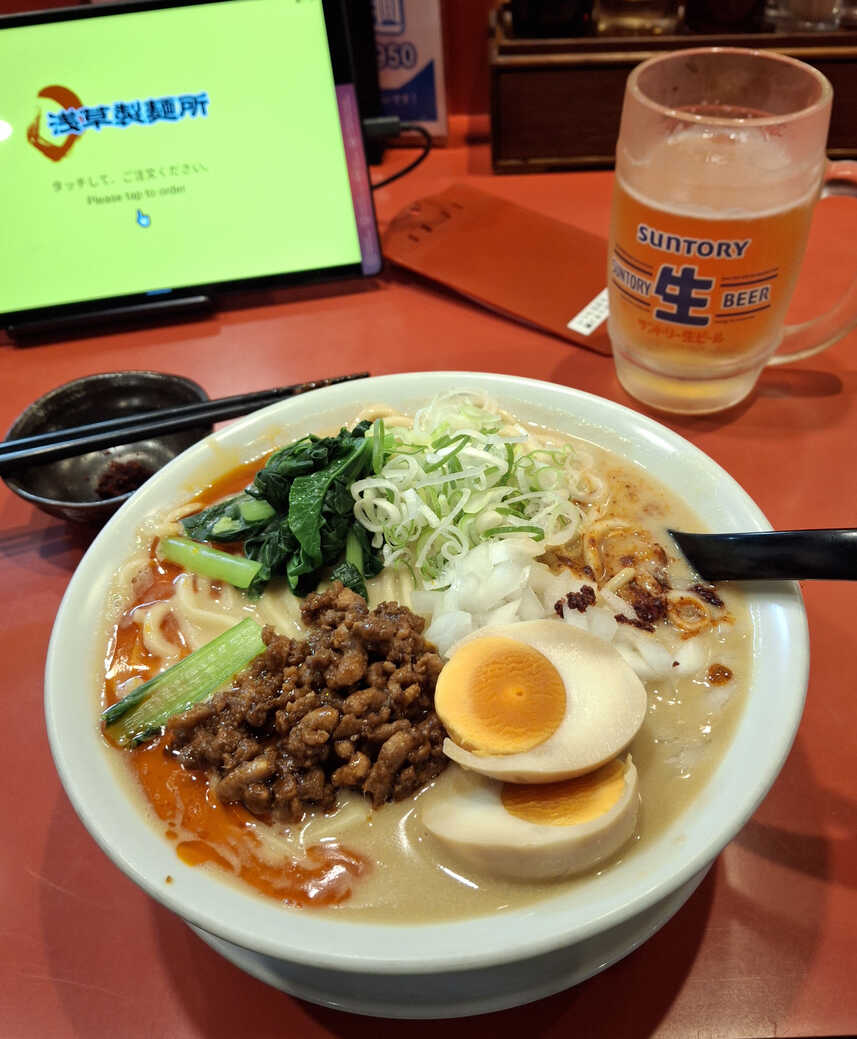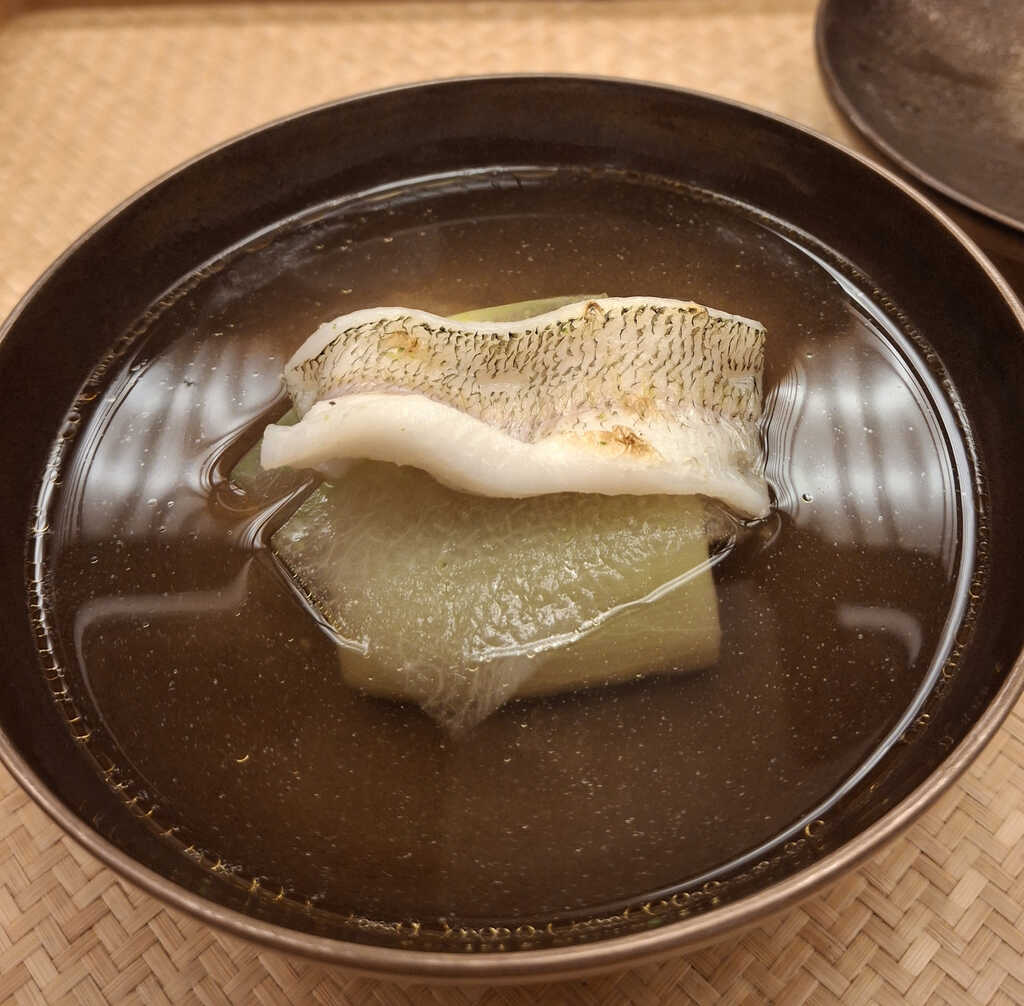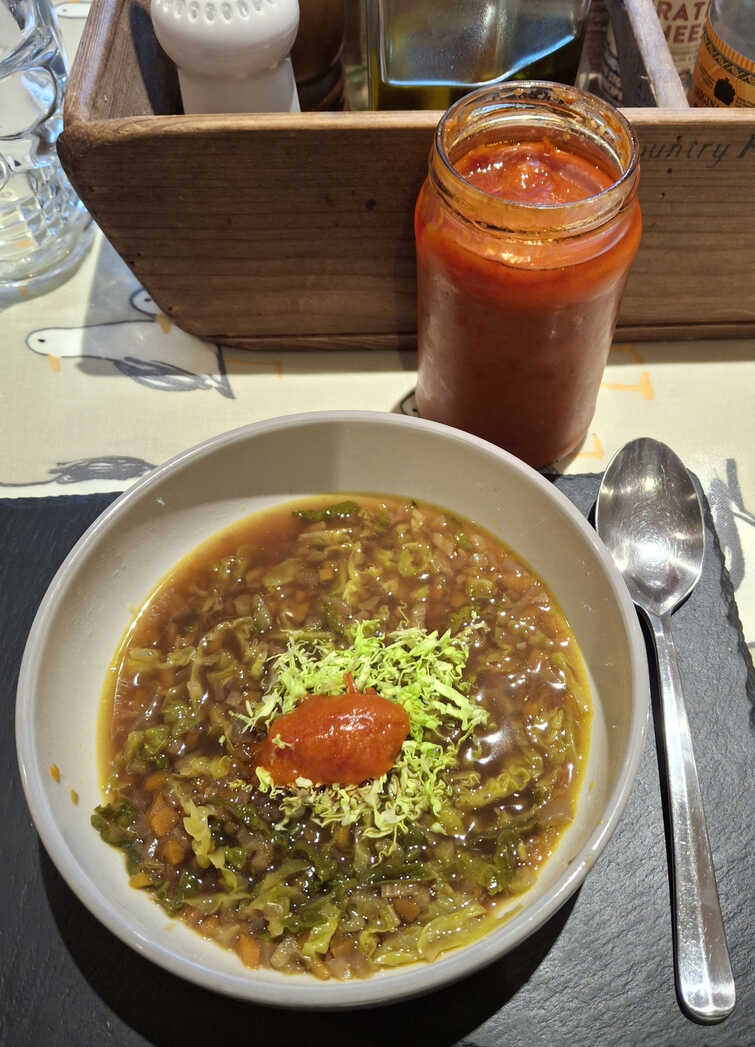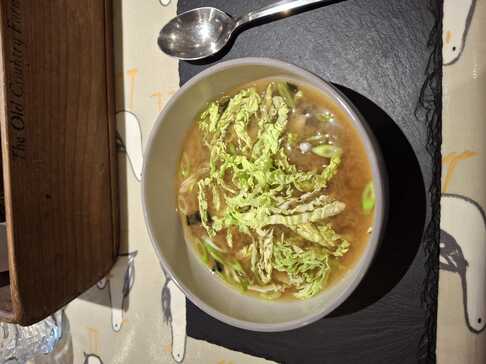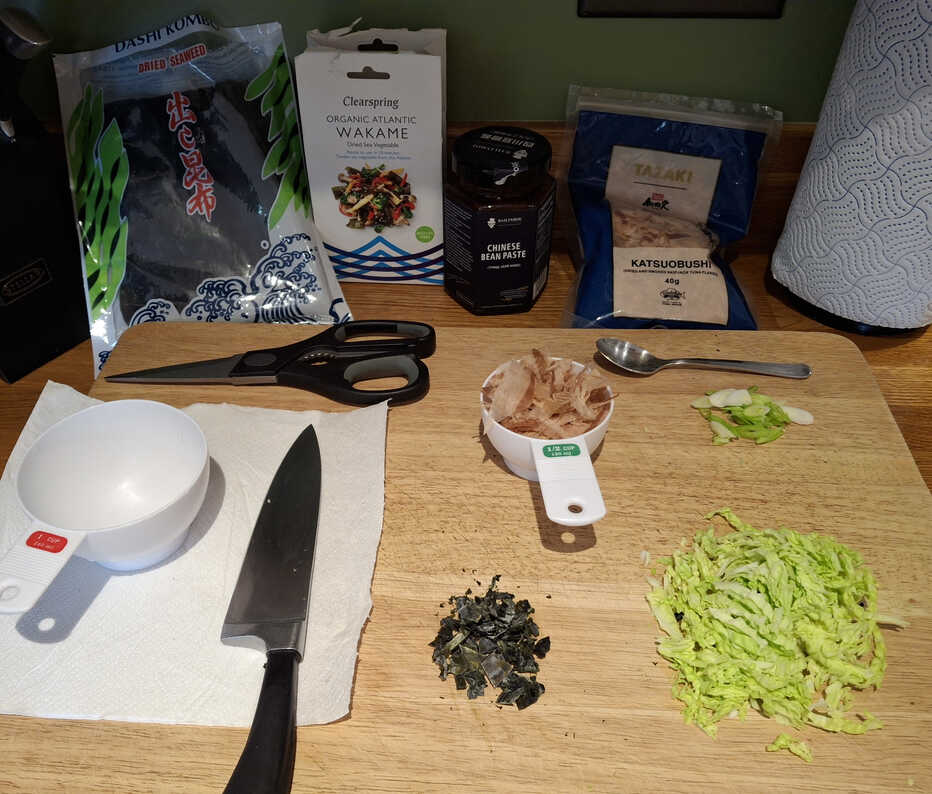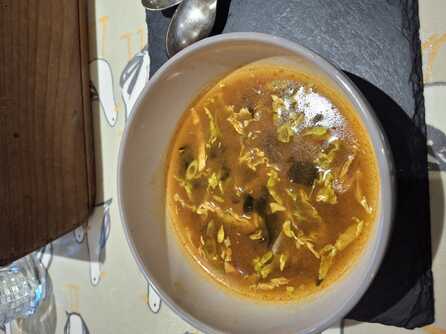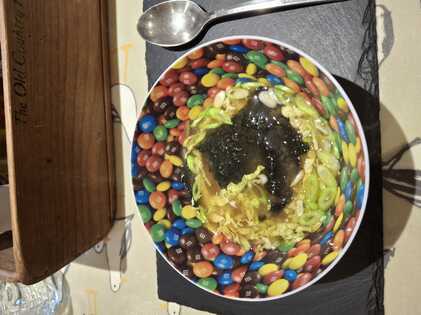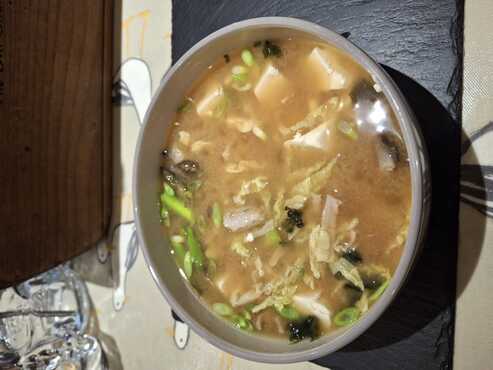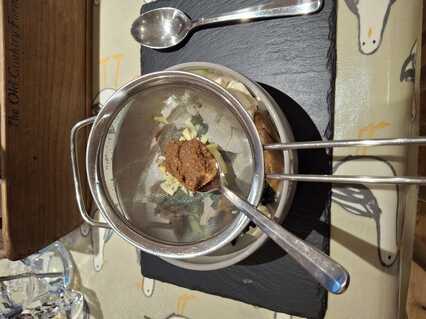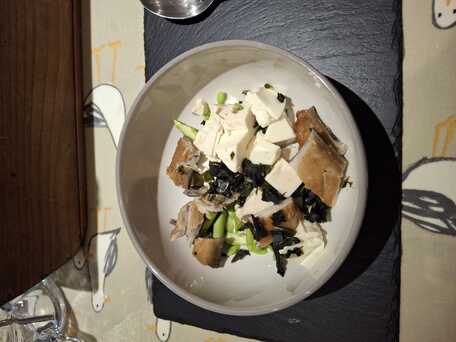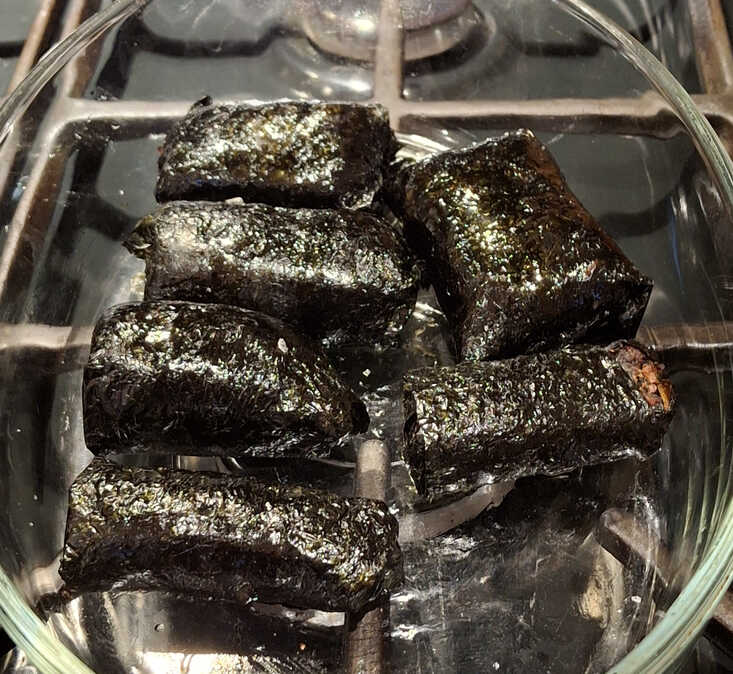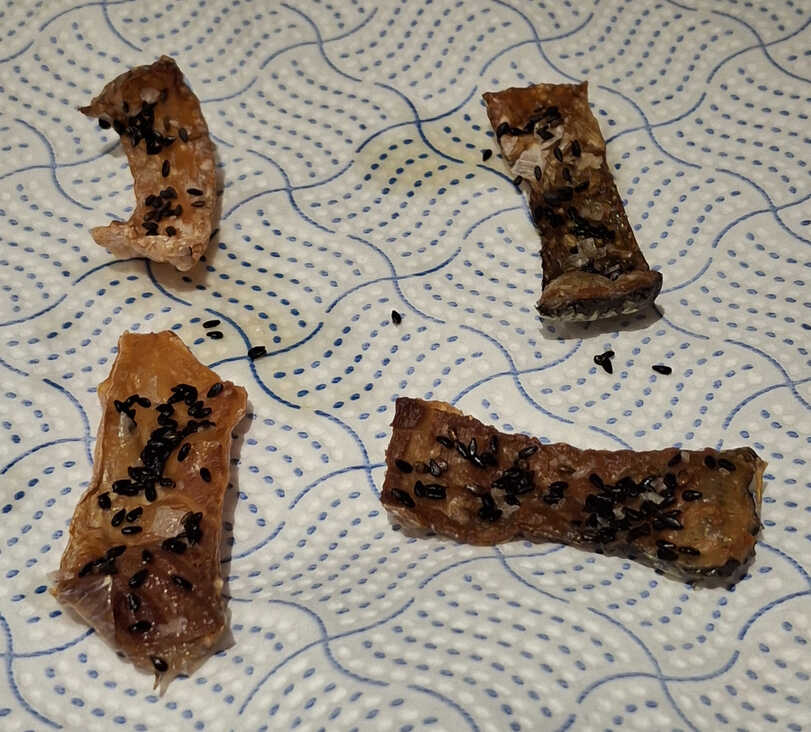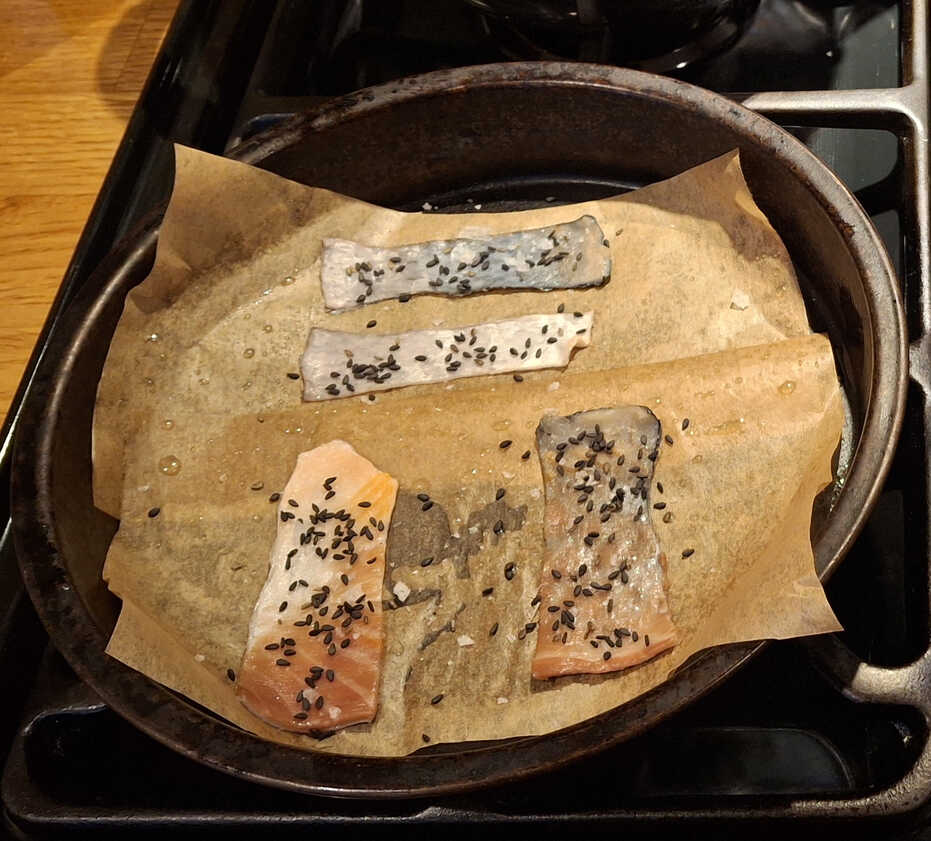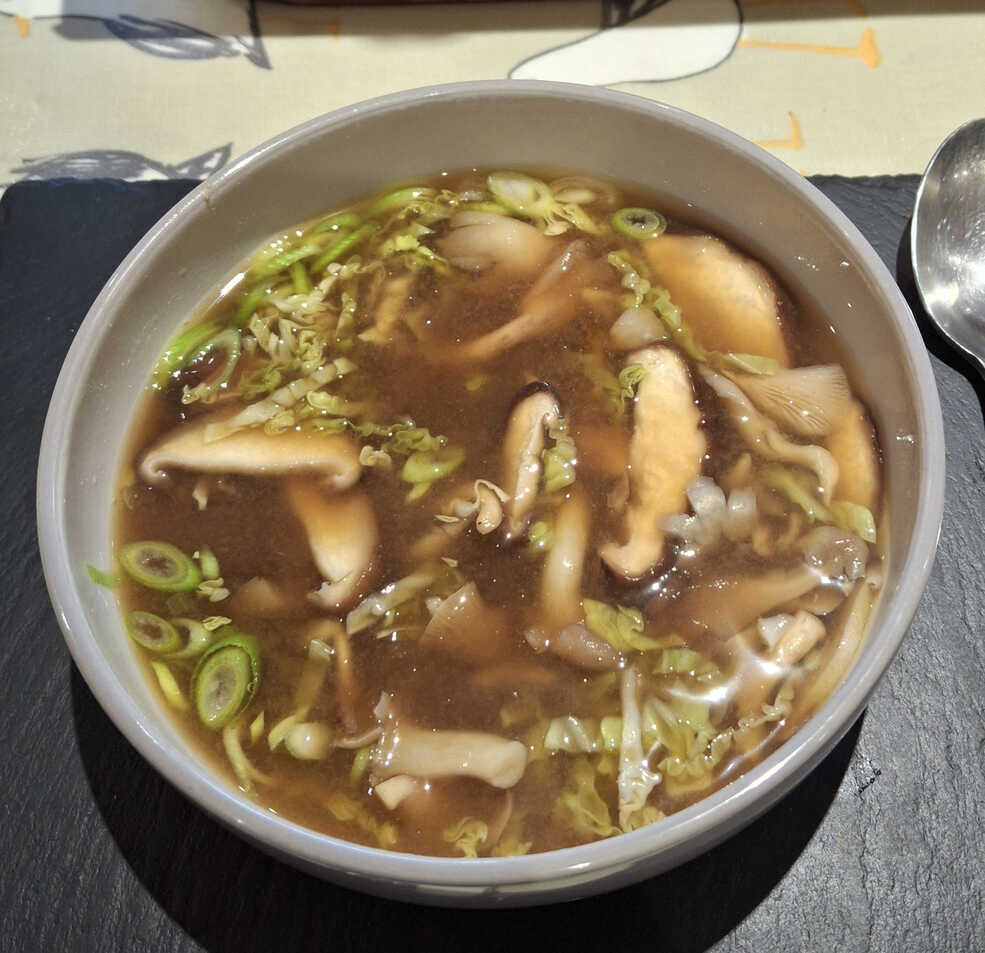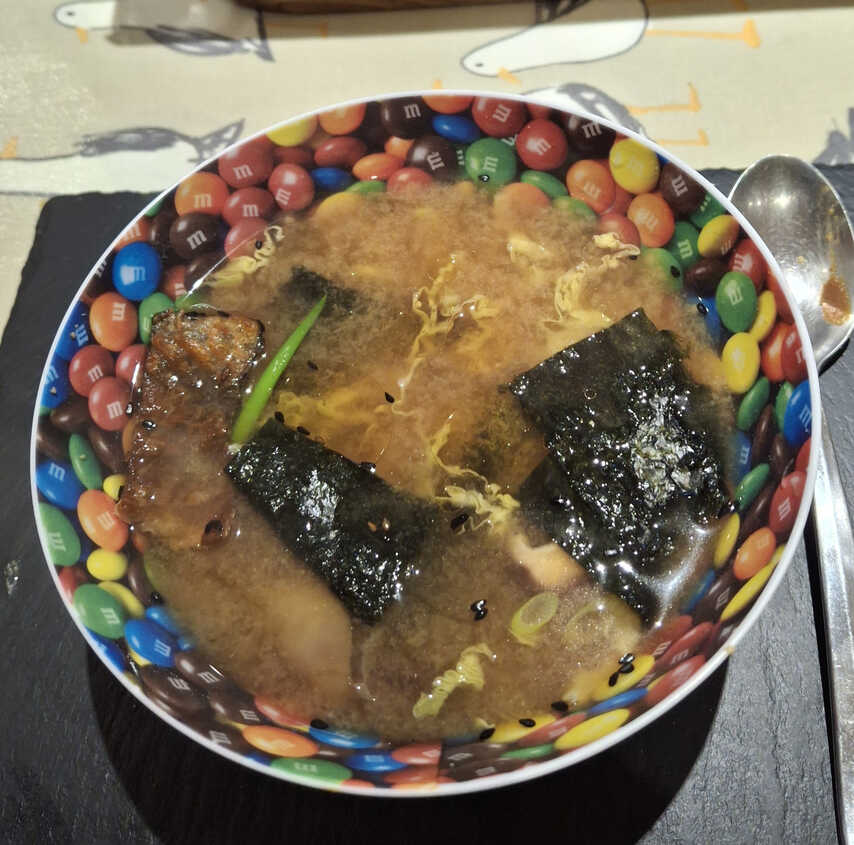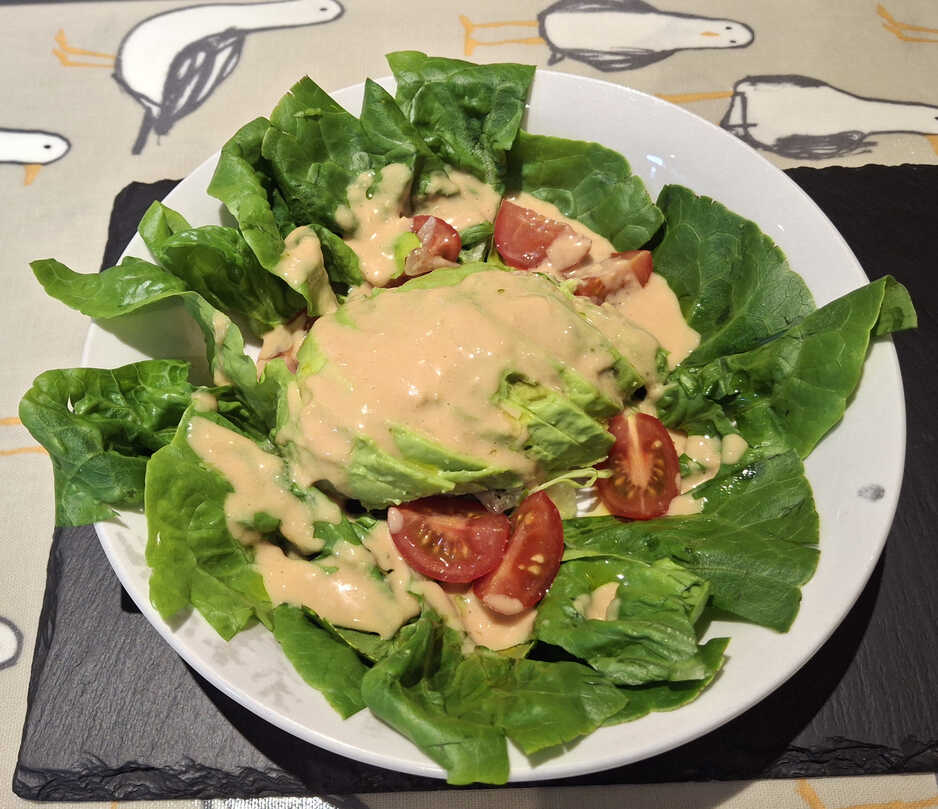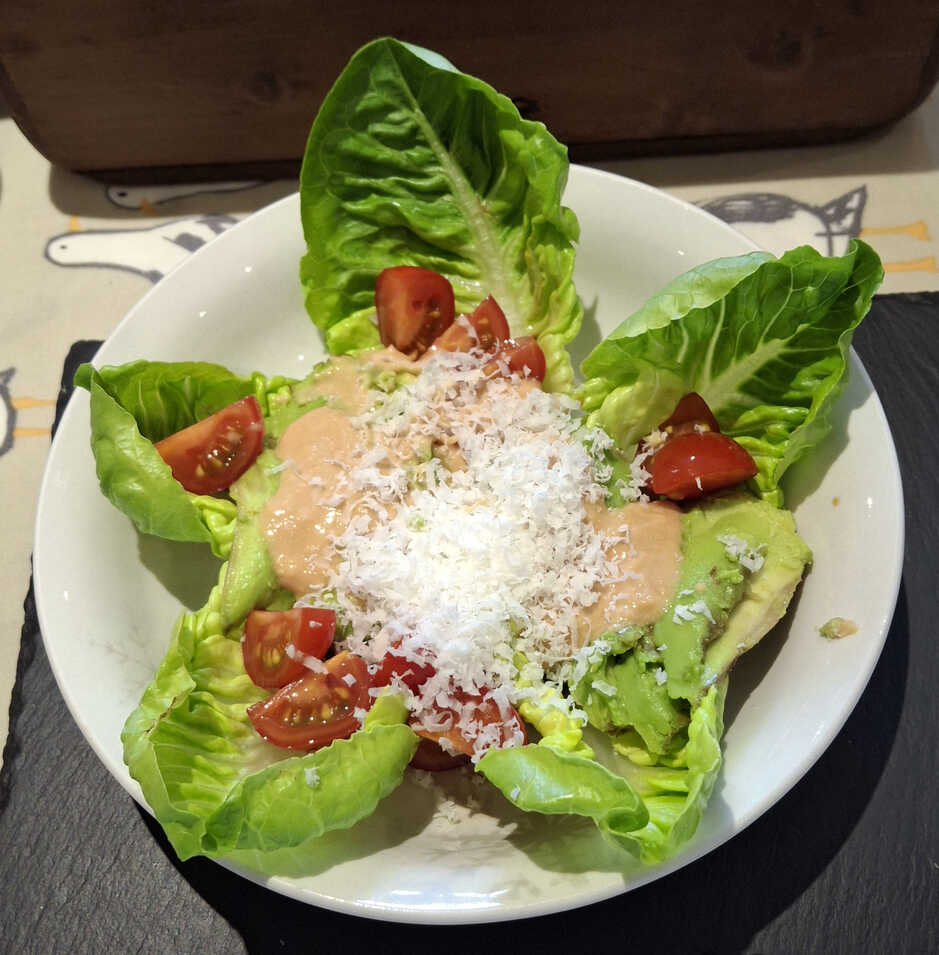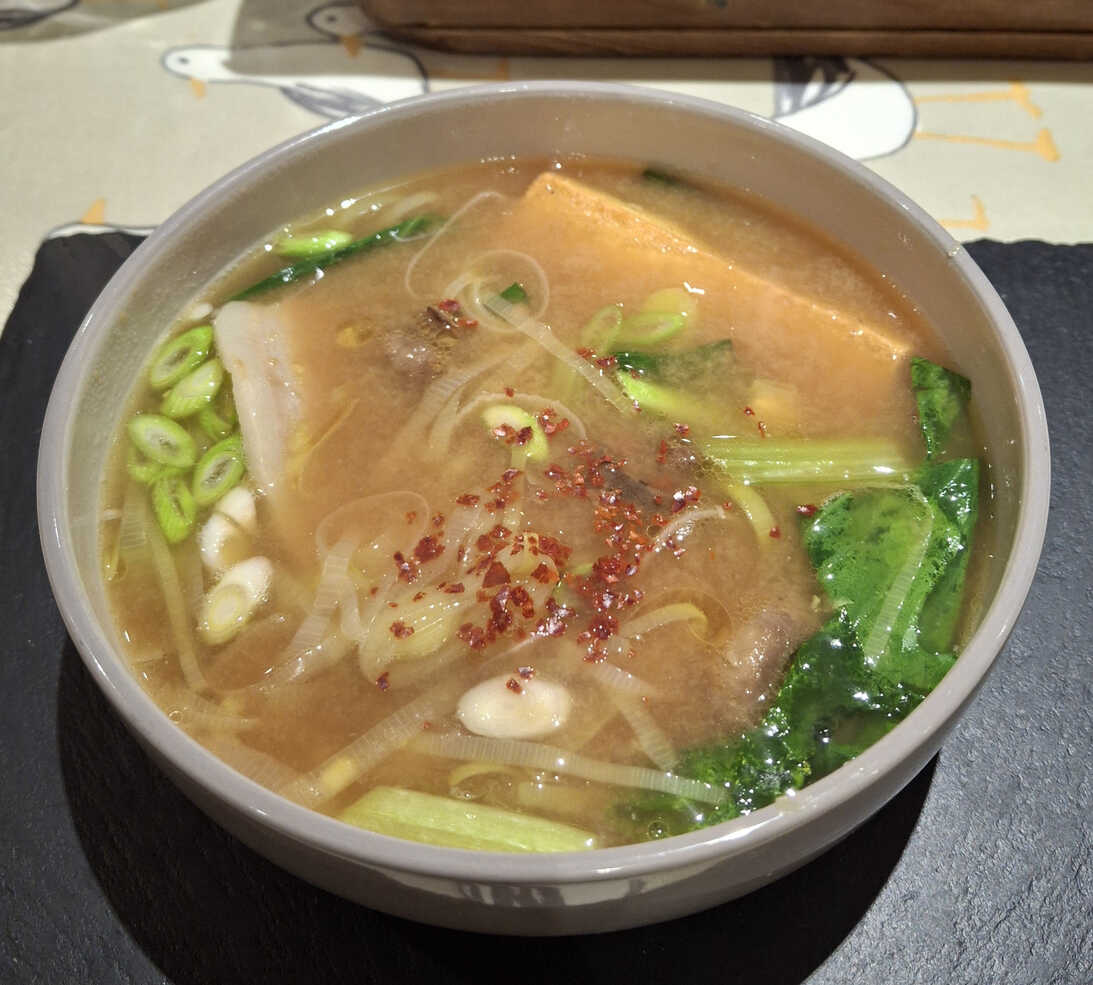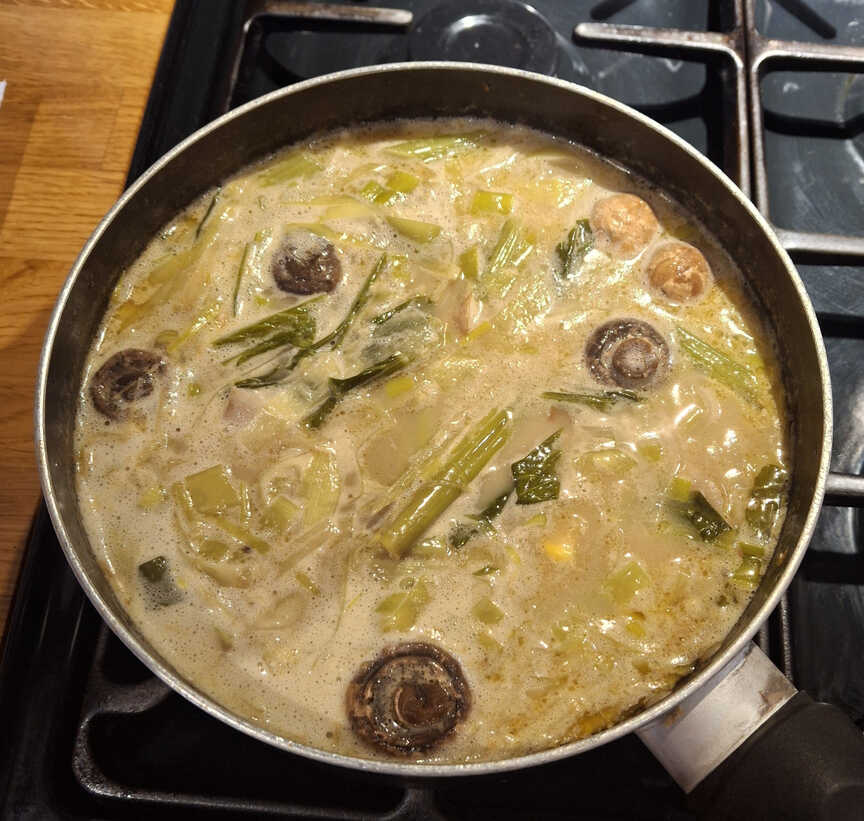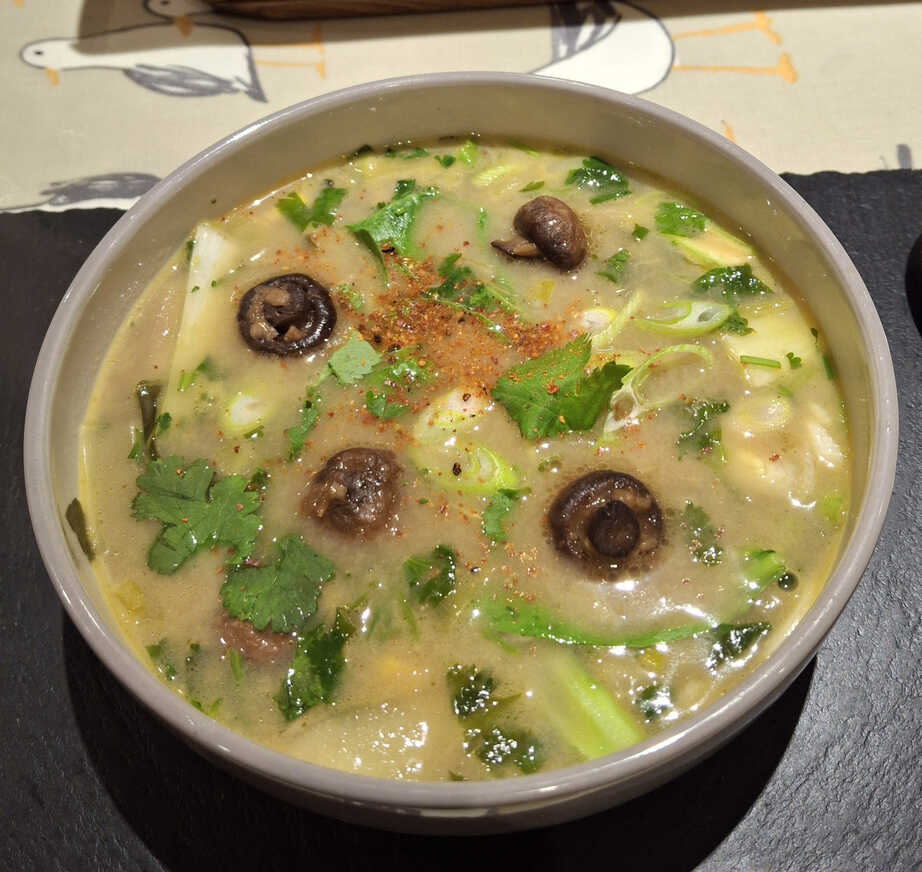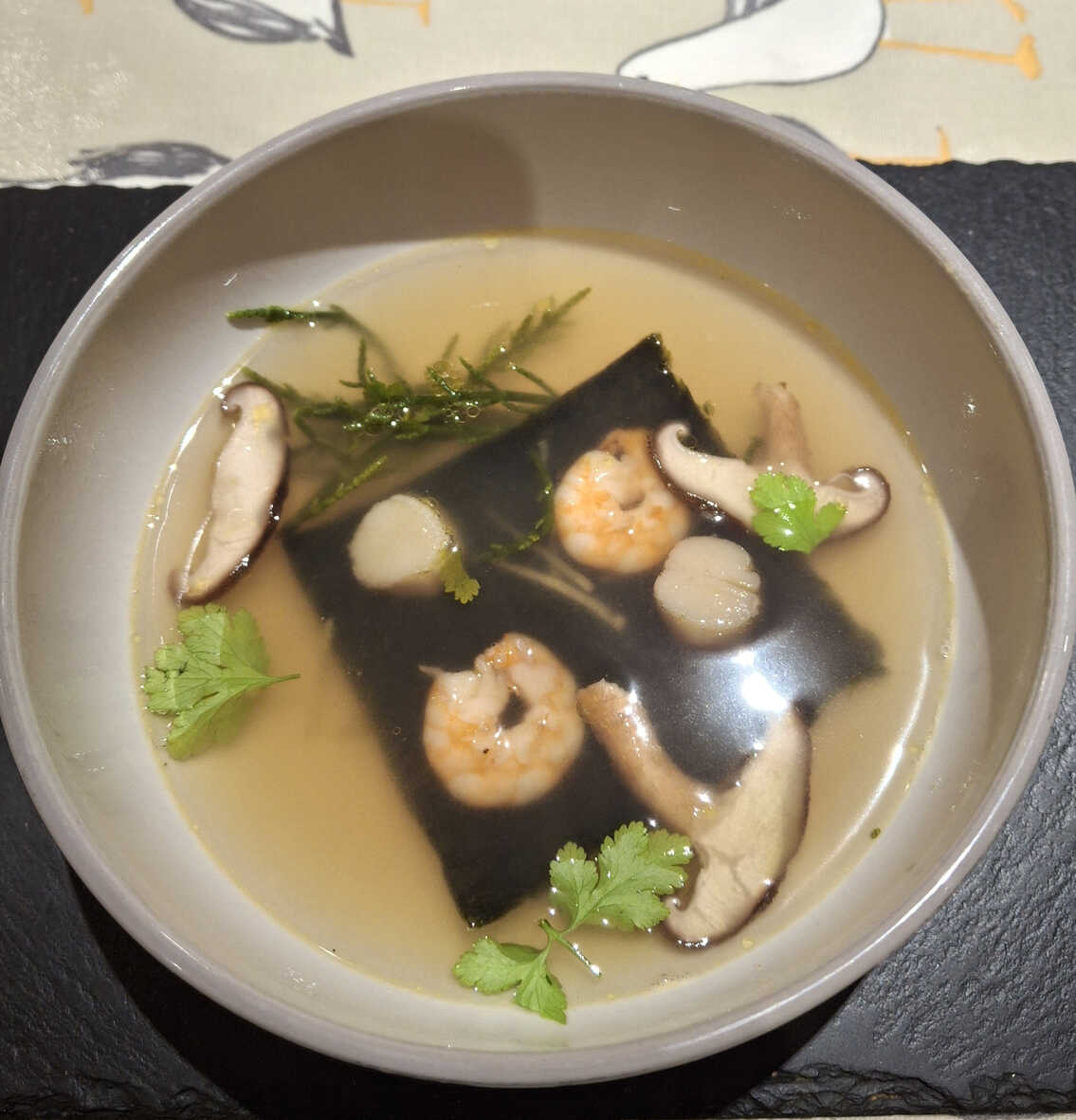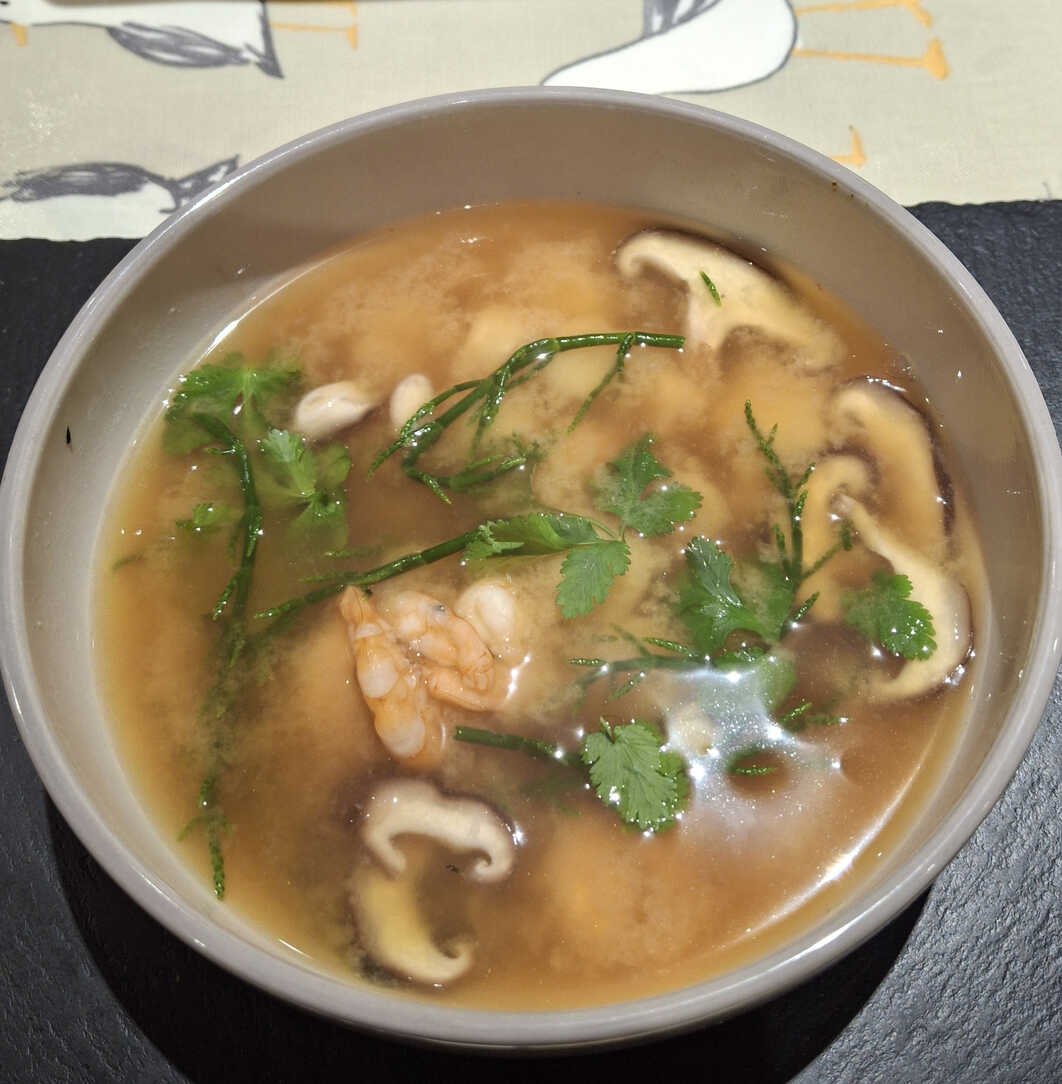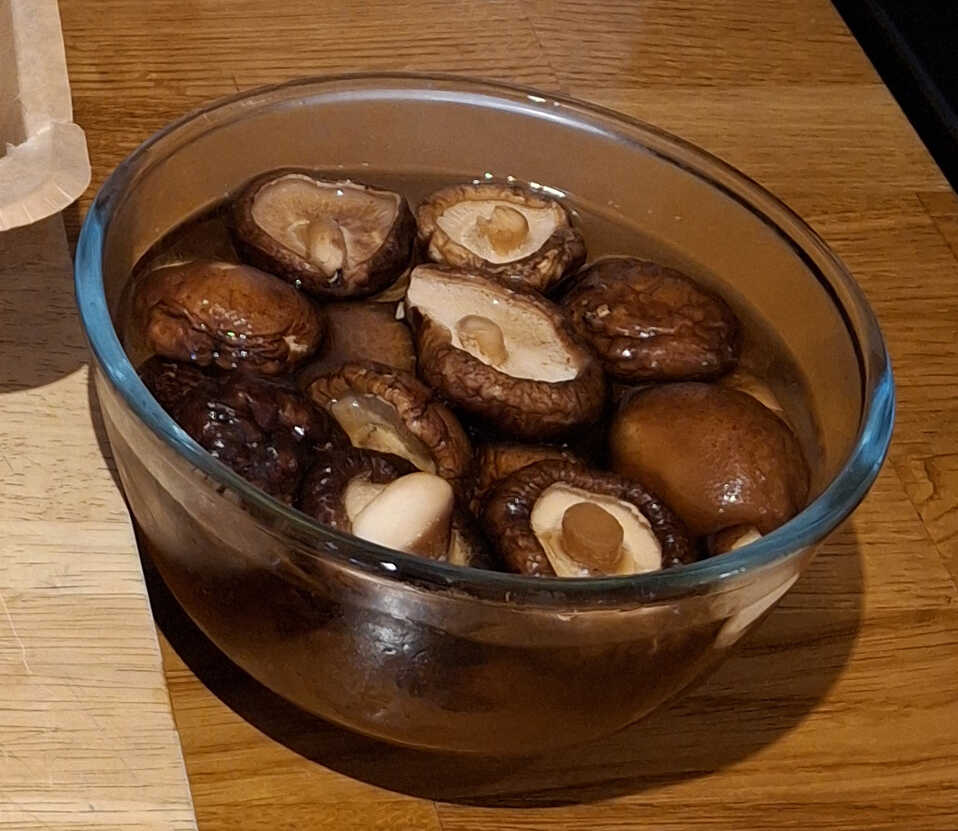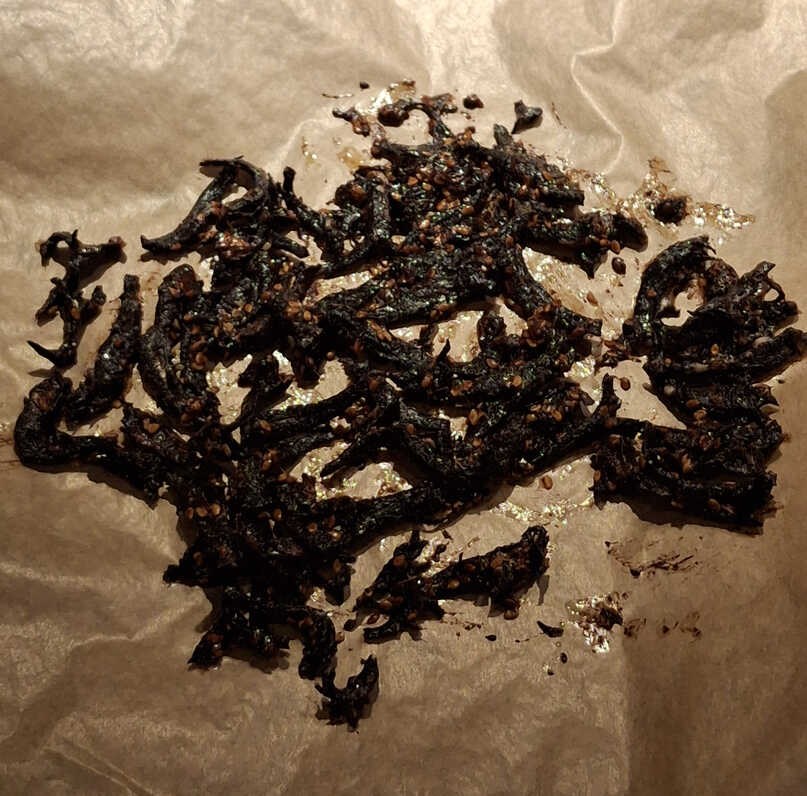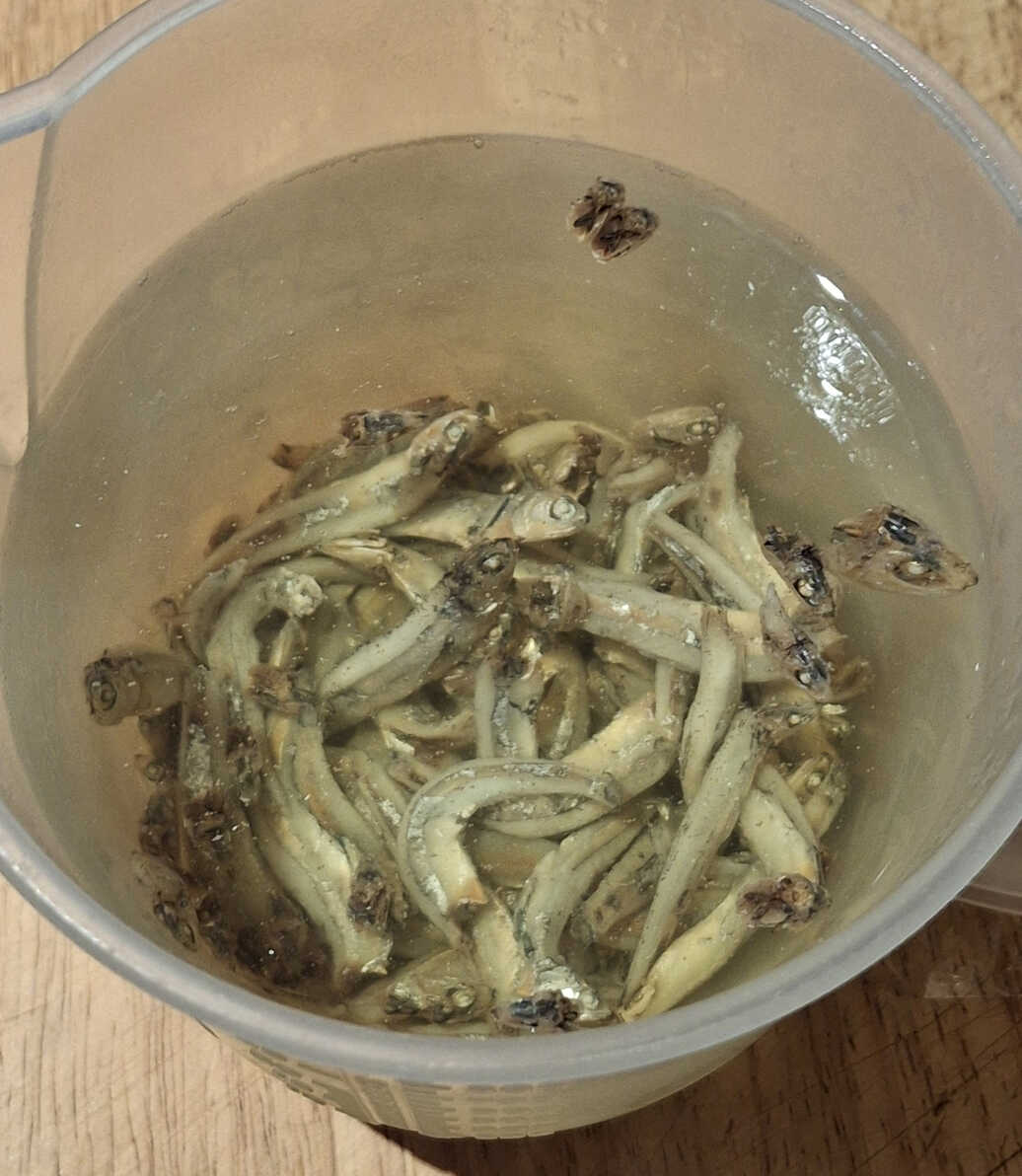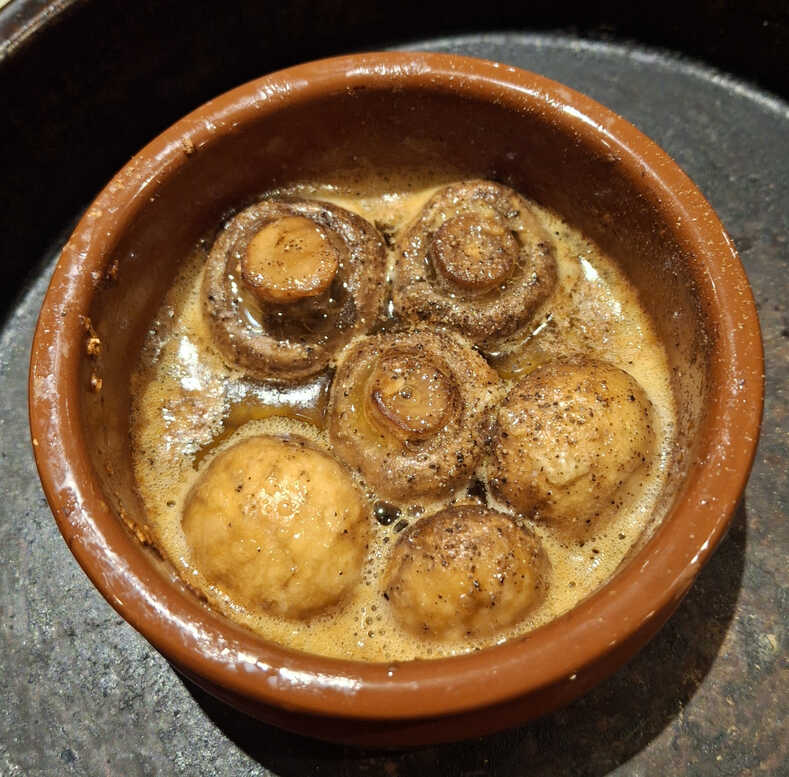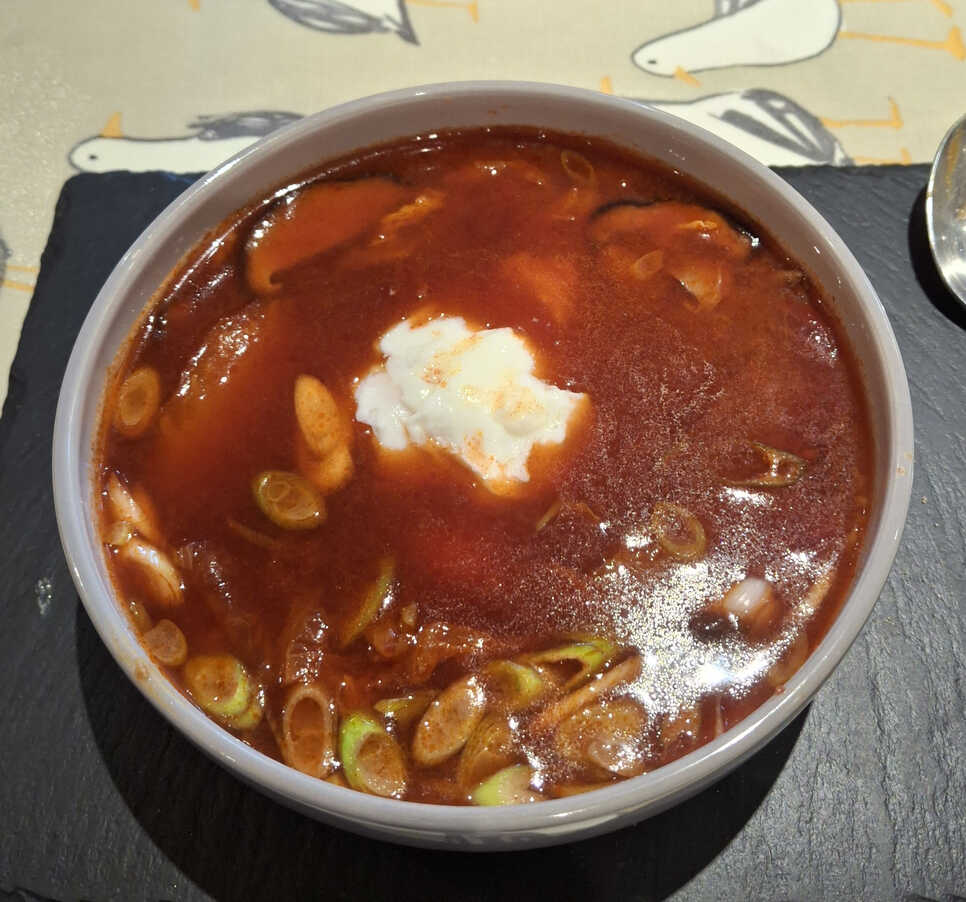
Miso Hungry

In homage to my recent visit to Japan,
this month I will be mostly eating Miso soup!
If I had one word of advice from this Japanese holiday it would be - don't visit in the summer. It's fucking hot.
And no, Hudson, it is not a dry heat.
It is, in fact, unbearably humid.
And being constantly dripping with sweat (I recommend a face-and-body terry cloth) really drives home how much worse it is being a fat bastard.
And hence the soups. Another desperate, and likely futile, attempt to lose some weight.
Apart from miso ramen, which is basically miso soup heaving with noodles, whilst in Japan I only really had miso soup as a small side dish or as one element in a long kaiseki meal; more a palate cleanser than a course.
It's not terribly exciting, I have to say, but it does pack quite a lot of flavour into an otherwise very thin soup.
And thin soup is definitely my target here.
Even if larger lumps do have a tendency to creep in as I get hungrier and hungrier 🙄
You can, of course, make a regular vegetable soup (squash, say), but use dashi as the stock and add miso flavourings. But here I'm really talking about a soup which is primarily miso, with added bits.
Here are some ideas for enhancing your miso soup, though you should really try to avoid turning it into a stew:
And I suppose it ended when I discovered that hoard of poisonous mushrooms....
If I had one word of advice from this Japanese holiday it would be - don't visit in the summer. It's fucking hot.
And no, Hudson, it is not a dry heat.
It is, in fact, unbearably humid.
And being constantly dripping with sweat (I recommend a face-and-body terry cloth) really drives home how much worse it is being a fat bastard.
And hence the soups. Another desperate, and likely futile, attempt to lose some weight.
Apart from miso ramen, which is basically miso soup heaving with noodles, whilst in Japan I only really had miso soup as a small side dish or as one element in a long kaiseki meal; more a palate cleanser than a course.
It's not terribly exciting, I have to say, but it does pack quite a lot of flavour into an otherwise very thin soup.
And thin soup is definitely my target here.
Even if larger lumps do have a tendency to creep in as I get hungrier and hungrier 🙄
You can, of course, make a regular vegetable soup (squash, say), but use dashi as the stock and add miso flavourings. But here I'm really talking about a soup which is primarily miso, with added bits.
Here are some ideas for enhancing your miso soup, though you should really try to avoid turning it into a stew:
- Adding cubed tofu and sliced spring onions is standard.
- Simmer up rooty vegetables like potatoes, turnip (particularly Japanese), radish or daikon, burdock root, yam, taro (satoimo), squash.
- Throw in kale ribs and kelp or any other kitchen garbage you have spare at the beginning of cooking, and discard the ribs at the end of cooking.
- Cook in a bare handful or two of rice, ramen or soba noodles, left whole (for slurping) or cut into smaller pieces (minimal slurping).
Though now this is getting uncomfortably close to being a bowl of ramen. - Briefly cook: Sliced celery, sliced zucchini, sliced carrots, fresh or frozen corn kernels, sliced nappa cabbage, sliced bok choy, etc…
- Throw in a handful of seaweed at the end: Crumbled nori, wakame, arame, hijiki.
- Include cubed chicken breasts, thinly sliced pork belly, or slices of char siu. Make sure to properly cook raw meat.
- With the soup at a low simmer, pour in beaten egg in a circular pattern. Don’t stir the soup, and don’t let it come up to a boil.
- Throw in a cup of sake for added punch.
- Throw in a can of coconut milk for a richer soup.
- Throw in chopped cilantro and lemongrass.
What with the coconut milk, you're now in danger of making Thai tom kha. - Add shrimp, prawns, crab meat, clams are popular, or any kind of fish really, particularly smoked mackerel. Just bring these up to temperature.
- Add bright green vegetables such as snow peas, spinach leaves, watercress leaves, asparagus sections, broccoli spears or string beans
at the very end of cooking, after the soup comes to a boil, so that they retain their bright color.
You can basically just put them in the bowl and pour the soup over. - Add mushrooms, although they are best served in a dashi made from dried mushrooms.
- Add an onsen egg, or a seasoned boiled egg cut in half. Best added freezing cold for a nice temperature contrast!
- Season with a good squeeze of anchovy paste (in which case reduce the amount of miso).
- Flavour with pickles like kyurizuke, chilli pastes like doubanjiang, crispy chilli oil, or a flavoured oil like sesame. And of course, kimchi!.
- Sprinkle with shichimi togarashi; seven-flavoured chilli mix, for that Japanese authenticity.
And I suppose it ended when I discovered that hoard of poisonous mushrooms....
Luxurious Cabbage Soup
soup veg vegan
Now, to be fair, I didn't include the fennel, beans, nor the tomato paste. But no, dear reader, this is not luxurious.
I think PBS has spent too much time in Eritrea. Haven't they been de-funded yet?
It takes a good dump of Marmite just to make it palatable, or enough chilli paste in this case a gift of mysterious Czech origins to stun a goat.
And that's even with a pretty strong chicken stock.
It takes a good dump of Marmite just to make it palatable, or enough chilli paste in this case a gift of mysterious Czech origins to stun a goat.
And that's even with a pretty strong chicken stock.
Serves 8
Ingredients
- 3 tablespoons olive oil, plus more for drizzling
- 1 medium-size onion, coarsely chopped (about 2 cups)
- 2 medium-size carrots, coarsely chopped (about 1 cup)
- 1 small fennel bulb, cored and coarsely chopped (about 1 cup) Or chopped leeks?.
- 3 garlic cloves, peeled and crushed
- ¼ cup tomato paste
- 6 cups richly flavored vegetable or chicken stock, preferably homemade
- 1 very small cabbage (preferably Savoy), cored and thinly shredded (about 1 pound or 8 cups shredded)
- 2 pieces Parmesan rind
- 3 cups cooked white beans, drained
- 1 tablespoon sherry or unfiltered apple cider vinegar Or you might use lemon juice.
- 1 tablespoon fresh thyme leaves
- ¼ cup thinly sliced fresh basil leaves
- Kosher salt, ground black pepper, and crushed red pepper flakes, to taste
Place the onion, carrots, fennel, and garlic in the bowl of a food processor and pulse until very finely chopped, just short of a puree. (Alternatively, chop the vegetables as finely as possible with a knife.)
Warm the oil in a small soup pot over medium heat. Stir in the onion mixture and a big pinch of salt. Cover and cook until very soft, similar to a sauce, about 10 minutes, stirring often.
Increase the heat to medium-high. Stir in the tomato paste and cook until the mixture begins to sizzle, about 1 minute, stirring quickly and continuously.
Stir in 6 cups of the stock and bring to a simmer.
Stir in the cabbage and another big pinch of salt.
Drop in the Parmesan rinds.
Simmer the soup until the cabbage is tender, about 20 minutes, stirring occasionally.
Retrieve the cheese rinds and either discard (a waste!) or nibble them as a cook’s treat.
Stir in the beans, vinegar, and thyme. Add more stock if the soup is too thick.
Return to a simmer and cook until warmed through, about 5 minutes.
Just before serving, stir in the basil. Season generously with salt, pepper, and pepper flakes. And increasingly desperately with marmite and hot chilli paste.
Serve warm, drizzled with more olive oil, if you like.
Warm the oil in a small soup pot over medium heat. Stir in the onion mixture and a big pinch of salt. Cover and cook until very soft, similar to a sauce, about 10 minutes, stirring often.
Increase the heat to medium-high. Stir in the tomato paste and cook until the mixture begins to sizzle, about 1 minute, stirring quickly and continuously.
Stir in 6 cups of the stock and bring to a simmer.
Stir in the cabbage and another big pinch of salt.
Drop in the Parmesan rinds.
Simmer the soup until the cabbage is tender, about 20 minutes, stirring occasionally.
Retrieve the cheese rinds and either discard (a waste!) or nibble them as a cook’s treat.
Stir in the beans, vinegar, and thyme. Add more stock if the soup is too thick.
Return to a simmer and cook until warmed through, about 5 minutes.
Just before serving, stir in the basil. Season generously with salt, pepper, and pepper flakes. And increasingly desperately with marmite and hot chilli paste.
Serve warm, drizzled with more olive oil, if you like.
Bland, bland, bland.
Miso Soup with Cabbage
soup veg vegan
Why cabbage? Why all this cabbage?
Well, I had leftovers from my luxurious soup, and a little goes a long way finely minced into miso soup.
You'll generally want to muddle about 1 or 2 tablespoons of miso paste per bowl of soup.
You can press the paste through a sieve if you like to get rid of all the grainy bits, otherwise it's a good idea to prevent clumping by blending a few drops of soup into the miso paste in a small bowl to loosen the paste up before adding it back to the rest of the soup, as you would with cornflour.
In any case avoid boiling the miso paste, after adding to the broth, which will degrade its flavour.
Well, I had leftovers from my luxurious soup, and a little goes a long way finely minced into miso soup.
You'll generally want to muddle about 1 or 2 tablespoons of miso paste per bowl of soup.
You can press the paste through a sieve if you like to get rid of all the grainy bits, otherwise it's a good idea to prevent clumping by blending a few drops of soup into the miso paste in a small bowl to loosen the paste up before adding it back to the rest of the soup, as you would with cornflour.
In any case avoid boiling the miso paste, after adding to the broth, which will degrade its flavour.
Per Bowl
Ingredients
- awase dashi
- 1 spring onion, sliced
- a grab of wakame, larger or thicker pieces chopped
- 1 Tblsp miso paste
- handful cabbage, shredded
- doubanjiang fermented chilli bean paste optional
Shred your cabbage, slice your spring onion, chop up any large or fibrous chunks of the seaweed, and put them all in a bowl.
Heat the dashi to boiling and pour into the bowl to cover everything.
Scoop a tablespoon of miso paste into a sieve and dunk the sieve into the soup, stirring and pressing with the spoon until the miso strains into the soup, leaving the larger lumps and grains behind.
Add a spoonful of Doubanjiang if you want to spice it up a bit.
Serve.
Heat the dashi to boiling and pour into the bowl to cover everything.
Scoop a tablespoon of miso paste into a sieve and dunk the sieve into the soup, stirring and pressing with the spoon until the miso strains into the soup, leaving the larger lumps and grains behind.
Add a spoonful of Doubanjiang if you want to spice it up a bit.
Serve.
Pleasant enough, if a bit bland.
It actually develops more flavour to heat the cabbage up with the dashi as in the next exciting soup recipe.
It actually develops more flavour to heat the cabbage up with the dashi as in the next exciting soup recipe.
Miso Soup with Cabbage AND Garlic
soup veg vegan
Ooooh. It's like Cabbage Miso Soup. But with flavour. Finally!
Per Bowl
Ingredients
- awase dashi
- handful cabbage, shredded
- 2 garlic cloves, crushed
- 1 Tblsp miso paste
- pinch ground black pepper
Toppings:- spring onion, sliced
- Tablespoon mirin
- spoon of soy sauce
- spoon of sesame oil
Make up your dashi, put it on the stove in pot, add the shredded cabbage and slowly bring to the boil.
Puré a couple of garlic cloves with a grind of black pepper, and put them a sieve with a tablespoon of miso paste.
Pour the soup into a bowl, lower in the sieve and swirl the paste with a spoon until it dissolves into the soup, leaving any lumps behind.
Add a splash of mirin, a drizzle of sesame oil and a dash of soy sauce.
Scatter over a sliced spring onion and serve.
Puré a couple of garlic cloves with a grind of black pepper, and put them a sieve with a tablespoon of miso paste.
Pour the soup into a bowl, lower in the sieve and swirl the paste with a spoon until it dissolves into the soup, leaving any lumps behind.
Add a splash of mirin, a drizzle of sesame oil and a dash of soy sauce.
Scatter over a sliced spring onion and serve.
Getting better - more flavour.
Even without an extra spoonful of doubanjiang.
Even without an extra spoonful of doubanjiang.
Miso Soup with Kimchi
soup veg vegan
Another Miso Soup with Cabbage. But this time it's pickled!
Per Bowl
Ingredients
- dashi
- finely sliced vegetables: cabbage, beetroot, mushrooms, etc
- 1 Tblsp miso paste
- 1-2 cloves garlic
- spring onion, sliced
- handful kimchi
Optional Extras:- 1 onsen tamago soft-boiled egg
- tsp doubanjiang chilli paste
Bring the dashi to a boil together with any finely sliced vegetables you fancy, such as the cabbage, beetroot and shitake mushrooms I used.
Throw some sliced spring onions into a bowl, pour over the hot soup and immerse into it a strainer with the miso paste and a few crushed garlic cloves.
Swirl the contents around until they dissolve into the soup, leaving any lumps or grains behind.
Add the kimchi, as much of the kimchi water as you fancy and optionally a Japanese soft-boiled egg (removed from the shell!).
Spice it up with Korean chilli paste if you like (which you can also push through the sieve if you want to avoid the bits).
Throw some sliced spring onions into a bowl, pour over the hot soup and immerse into it a strainer with the miso paste and a few crushed garlic cloves.
Swirl the contents around until they dissolve into the soup, leaving any lumps or grains behind.
Add the kimchi, as much of the kimchi water as you fancy and optionally a Japanese soft-boiled egg (removed from the shell!).
Spice it up with Korean chilli paste if you like (which you can also push through the sieve if you want to avoid the bits).
The more of them I'm forced to eat, the more interesting these soups are getting 😉
Smoked Mackerel Miso Soup
soup fish
Miso soups are often dressed with sliced spring onion, but asparagus makes a good alternative, or addition too.
I usually chop the asparagus stalks into longer pieces though.
As you can tell, I still have cabbage to use up.
When you're just adding it, finely sliced, to daily bowls of soup, a head of cabbage goes a loooooooong way! Feel free to leave it out though 😉
Smoked mackerel is a fine, I'd almost say natural, addition to miso soup. The flavours work very well together.
You could use awase dashi broth or iriko dashi the fishy version as the soup base.
I usually chop the asparagus stalks into longer pieces though.
As you can tell, I still have cabbage to use up.
When you're just adding it, finely sliced, to daily bowls of soup, a head of cabbage goes a loooooooong way! Feel free to leave it out though 😉
Smoked mackerel is a fine, I'd almost say natural, addition to miso soup. The flavours work very well together.
You could use awase dashi broth or iriko dashi the fishy version as the soup base.
Per Bowl
Ingredients
- dashi
- 1-2 asparagus stalks, cut into segments
- spring onion, sliced
- 1 Tblsp miso paste
- a few pinches of wakame
- ginger, grated or julienned
- 1 smoked mackerel fillet, broken up
- silken tofu, cubed
- cabbage, thinly sliced
Slice the spring onion into a soup bowl.
Slice the asparagus stalks into segments on a bias, halve the thicker ones, add to the bowl.
Chop up the wakame with a heavy knife some pieces may be unpleasantly large, thick or fibrous otherwise. Add to the bowl.
Break or cut up the smoked mackerel fillet and add to the bowl.
Cut tofu into smallish cubes and add to the bowl.
Add sliced cabbage AGAIN! to the dashi and bring to the boil.
Pour into the bowl.
Grate or shred ginger and put in a small sieve with the miso paste. You can add some ginger slivers directly into the soup if you like.
Lower the sieve into the soup and mix in with a spoon until the paste dissolves out and only the lumps are left in the sieve.
Slice the asparagus stalks into segments on a bias, halve the thicker ones, add to the bowl.
Chop up the wakame with a heavy knife some pieces may be unpleasantly large, thick or fibrous otherwise. Add to the bowl.
Break or cut up the smoked mackerel fillet and add to the bowl.
Cut tofu into smallish cubes and add to the bowl.
Add sliced cabbage AGAIN! to the dashi and bring to the boil.
Pour into the bowl.
Grate or shred ginger and put in a small sieve with the miso paste. You can add some ginger slivers directly into the soup if you like.
Lower the sieve into the soup and mix in with a spoon until the paste dissolves out and only the lumps are left in the sieve.
Feel free to add kimchi juice and doubanjiang chilli paste, if you want to spice it up a bit.
Roast Nori Wrapped Salmon
fish snack side
It seemed like it might be fun to roast tiny wraps of miso-seasoned fish in nori (sushi sheet seaweed) as an addition for a miso soup.
I had, however, hope the nori would crisp up during the roasting, but it didn't. Which made them less enjoyable to eat.
But they were otherwise OK.
I'm sure you could try with white fish, but I used salmon.
I had, however, hope the nori would crisp up during the roasting, but it didn't. Which made them less enjoyable to eat.
But they were otherwise OK.
I'm sure you could try with white fish, but I used salmon.
Ingredients
- lozenges of fish
- miso paste
- sesame oil
Suggested Flavourings:- ginger, grated
- lemon zest, grated
- wasabi, grated
Preheat the oven to Gas Mark 6. Clean and skin your chosen fish, slice into bite-sized lozenges, and cut sections of nori large enough to fully wrap each chunk.
You can crisp up the salmon skin separately, if you like.
Smear the middle of the nori with miso paste and your choice of flavouring - grated lemon, ginger or wasabi.
Add a grind of black pepper if you like.
Wrap the fish, wetting the edges of the nori to hold them around the parcel.
Rub sesame oil over an oven dish and lay out the parcels inside, then add a drizzle more of oil over the top.
Bake at Gas Mark 6 for 10-15 minutes until cooked.
You can crisp up the salmon skin separately, if you like.
Smear the middle of the nori with miso paste and your choice of flavouring - grated lemon, ginger or wasabi.
Add a grind of black pepper if you like.
Wrap the fish, wetting the edges of the nori to hold them around the parcel.
Rub sesame oil over an oven dish and lay out the parcels inside, then add a drizzle more of oil over the top.
Bake at Gas Mark 6 for 10-15 minutes until cooked.
Go easy on the miso - as it can be overwhelmingly salty, but otherwise they're not too bad.
It would be better if you could think of a way of getting the seaweed to go crispy though: Deep-frying? You might need to coat them with cornflour, and you certainly wouldn't want them to leak.
It would be better if you could think of a way of getting the seaweed to go crispy though: Deep-frying? You might need to coat them with cornflour, and you certainly wouldn't want them to leak.
Crispy Salmon Skin
ingredient fish
Although they do taste a bit, well, fishy, these make excellent garnishes, components for a sushi hand roll, or soup topping when added at the last second.
Ingredients
- salmon skin
- salt, pepper
- sesame seeds, black preferably
Cut the salmon skin into strips and lay them out on a silicon baking mat, or silicon baking paper.
Be sure to press them down firmly so they flatten out with no air bubbles to reduce the inclination for curling.
Season the strips, dress with sesame seeds, and bake for 20-30 minutes at 200°C/400°F/Gas Mark 6.
Alternatively - you can deep-fry the skins, if you have oil you'll never need to use for anything other than fish.
You will first need to assiduously remove as much moisture as possible: Salt the skins, leave them for 20 minutes, then blot dry with thick paper towels.
Generously coat the entire fish skin in potato or corn starch.
Heat a pan of neutral oil to 170°C deep enough to submerge the skins.
Carefully lower in the floured skins (beware of spitting) and fry until they stop bubbling.
Remove and stack them to dry at something of an angle on paper towels, so the oil drains off them.
Alternatively - you can deep-fry the skins, if you have oil you'll never need to use for anything other than fish.
You will first need to assiduously remove as much moisture as possible: Salt the skins, leave them for 20 minutes, then blot dry with thick paper towels.
Generously coat the entire fish skin in potato or corn starch.
Heat a pan of neutral oil to 170°C deep enough to submerge the skins.
Carefully lower in the floured skins (beware of spitting) and fry until they stop bubbling.
Remove and stack them to dry at something of an angle on paper towels, so the oil drains off them.
Hmmm, crispy!
Mushroom Miso Soup
soup veg vegan
Ideally you will start your mushroom soup off with a shitake mushroom dashi.
It still turns out that a simple mushroom miso soup is a bit dull, which is why I kept adding extra ingredients:
The cabbage I've been using up for what seems like weeks, some experimental fishy parcels, and pieces crispy salmon skin.
If you want to try the pure mushroom version you'll probably still appreciate adding a dash of soy sauce, sesame oil and some ginger though.
It still turns out that a simple mushroom miso soup is a bit dull, which is why I kept adding extra ingredients:
The cabbage I've been using up for what seems like weeks, some experimental fishy parcels, and pieces crispy salmon skin.
If you want to try the pure mushroom version you'll probably still appreciate adding a dash of soy sauce, sesame oil and some ginger though.
Per Bowl
Ingredients
- mushroom dashi
- spring onions, sliced
- shitake or other mushrooms, sliced
- miso paste
- ginger, grated or julienned
- dash of soy sauce
- drizzle of sesame oil
Potential Extras:- crispy salmon skin
- nori-wrapped fish parcels
Slice or separate your fresh mushrooms, depending on what you've got.
Those bundles of tiny enoki mushrooms look rather good.
Heat the mushroom dashi with the fresh mushrooms, and sliced cabbage if you want.
Slice a spring onion into a soup bowl, and fill with the hot soup.
Lower a sieve into the soup containing some grated ginger and miso paste and rub them through the sieve with a spoon, keeping back any lumps an bits of ginger.
Add a dash of soy sauce and a drizzle of sesame oil, and serve.
Heat the mushroom dashi with the fresh mushrooms, and sliced cabbage if you want.
Slice a spring onion into a soup bowl, and fill with the hot soup.
Lower a sieve into the soup containing some grated ginger and miso paste and rub them through the sieve with a spoon, keeping back any lumps an bits of ginger.
Add a dash of soy sauce and a drizzle of sesame oil, and serve.
S'alright.
You could throw in a few roast nori wrapped fish if you like. And some shards of crispy roast salmon skin sprinkled with sesame seeds are particularly nice added just before serving.
It's quite nice to throw a few slivers of ginger into the actual soup too, not just sieve out their flavour. Just go easy.
You could throw in a few roast nori wrapped fish if you like. And some shards of crispy roast salmon skin sprinkled with sesame seeds are particularly nice added just before serving.
It's quite nice to throw a few slivers of ginger into the actual soup too, not just sieve out their flavour. Just go easy.
Miso Dressing
salad dressing veg vegan
Now that I've started eating miso paste, it's fun to find different things to do with it!
White miso paste is usually described as sweeter variety - but you'd be disappointed if you thought that it was going to taste like a dessert.
The main difference between white and brown or red miso is mostly that it just has a milder, more delicate flavour.
Might be nice to blend this up with a little tofu, to give it a thick, creamy base. Yep - that works well.
Even white miso paste is pretty salty, so you probably won't need to add any soy sauce, which I otherwise would.
It goes surprisingly well, as a dressing on an avocado salad for instance, with grated hard cheese. Particularly a hard goat's cheese. Yum!
White miso paste is usually described as sweeter variety - but you'd be disappointed if you thought that it was going to taste like a dessert.
The main difference between white and brown or red miso is mostly that it just has a milder, more delicate flavour.
Might be nice to blend this up with a little tofu, to give it a thick, creamy base. Yep - that works well.
Even white miso paste is pretty salty, so you probably won't need to add any soy sauce, which I otherwise would.
It goes surprisingly well, as a dressing on an avocado salad for instance, with grated hard cheese. Particularly a hard goat's cheese. Yum!
Makes about ½ Cup
Ingredients
- 2 tblsps white miso paste
- juice of 1 lemon
- 1 tblsp rice vinegar
- ½ tblsp sesame oil
- 1 tblsp tahini
- 3 garlic cloves
- 1-2 tsps honey or maple syrup
- splash of water
- black pepper
Optional Extras:- ginger root
- tofu
- clementine or orange juice
- cayenne or paprika powder
- Dijon mustard
Blend all the ingredients, add water or tofu liquid to lubricate if necessary, adjust for taste.
Dress your salad.
Dress your salad.
You can use the whole lemon flesh, minus any pith and seeds, if you like.
Tonjiru
Pork Miso Soup
Pork Miso Soup
soup meat
As far as I can tell, Japanes tonjiru, or as it is also regionally known, butajiru, is usually packed with rooty vegetables like carrot, onion, taro, burdock root and daikon.
And weirder substances like their rubbery, flavourless konnyaku.
This is a much thinner version with leeks instead of onion. The choi sum leaves bring some contrasting mustardy notes, though you could use cabbage or bok choy instead.
And weirder substances like their rubbery, flavourless konnyaku.
This is a much thinner version with leeks instead of onion. The choi sum leaves bring some contrasting mustardy notes, though you could use cabbage or bok choy instead.
Serves 4
Ingredients
- 2 litres mushroom dashi
- 170g/6oz slices pork belly
- knob of butter
- toasted sesame oil
- 1 leek, sliced
- 4 tblsps miso paste
- ½-1 cob corn
- a dozen roast garlic button mushrooms
- 100g abura-age - deep-fried tofu
- Japanese red pepper flakes (shichimi togarashi), or Korean gochugaru
- 4 spring onions, sliced
- 100g choi sum or cabbage, roughly chopped
Remove the pork skin, and any of the cartilaginous rib ends.
Slice the belly pork. You can stick it in the freezer for half an hour to firm it up first if you need to.
Discard the green leek stalk, and slice the white part.
Cut the choi sum stalks into bite-sized pieces, and trim the leaves to a manageable size.
Slice the corn kernels away from the cob.
Thinly slice the spring onions.
Make or buy the abura-age slices.
The Japanese seem to enjoy their belly pork sliced as thinly as bacon, but I rather like a fatter chunk myself. So choose your weapon. Heat butter with a dash of sesame oil and fry the belly pork until it loses its pinkness, and maybe even takes on a little golden colour at the edges. Add the sliced leeks and sweat gently until they collapse. Add the corn and then the choi sum stalks and swirl to coat in butter. Cover with the dashi and bring to a simmer, skimming off any foam which develops.
Off the heat, in the pan or individual bowls, lower a small sieve into the soup and muddle the miso paste until only the grains remain in the sieve. Put a handful of choi sum leaves, a few roast garlic mushrooms, a spoonful of their juice, and a piece of aburaage in each bowl. Ladle in the soup, then top off with spring onion slices, a drizzle more sesame oil and a sprinkle of shichimi togarashi if you like.
Discard the green leek stalk, and slice the white part.
Cut the choi sum stalks into bite-sized pieces, and trim the leaves to a manageable size.
Slice the corn kernels away from the cob.
Thinly slice the spring onions.
Make or buy the abura-age slices.
The Japanese seem to enjoy their belly pork sliced as thinly as bacon, but I rather like a fatter chunk myself. So choose your weapon. Heat butter with a dash of sesame oil and fry the belly pork until it loses its pinkness, and maybe even takes on a little golden colour at the edges. Add the sliced leeks and sweat gently until they collapse. Add the corn and then the choi sum stalks and swirl to coat in butter. Cover with the dashi and bring to a simmer, skimming off any foam which develops.
Off the heat, in the pan or individual bowls, lower a small sieve into the soup and muddle the miso paste until only the grains remain in the sieve. Put a handful of choi sum leaves, a few roast garlic mushrooms, a spoonful of their juice, and a piece of aburaage in each bowl. Ladle in the soup, then top off with spring onion slices, a drizzle more sesame oil and a sprinkle of shichimi togarashi if you like.
Shichimi Togarashi is Japanese seven spice chilli pepper - a mix of chilli pepper flakes and other spices.
Korean gochugaru - pure chilli flakes - is a reasonable, if less complex, alternative.
You could also add crushed garlic or grated ginger to the soup if you liked, or use leaner pork loin instead of belly.
Either way, it's pretty tasty.
You could also add crushed garlic or grated ginger to the soup if you liked, or use leaner pork loin instead of belly.
Either way, it's pretty tasty.
Pork Miso Soup with Lemongrass and Coconut Milk
meat soup
A very Thai-style miso soup.
Basically Tonjiru with lemongrass, coconut milk and optionally coriander.
Iriko or Niboshi which seem to be different words for the same thing! dashi is made with dried baby sardines or anchovies and would be the ideal base for this soup.
I actually used chicken stock though, and added some fish sauce to compensate.
Iriko or Niboshi which seem to be different words for the same thing! dashi is made with dried baby sardines or anchovies and would be the ideal base for this soup.
I actually used chicken stock though, and added some fish sauce to compensate.
Serves 4
Ingredients
- 2l iriko/niboshi dashi, or stock
- 170g/6oz slices pork belly
- knob of butter
- 1-2" root ginger
- toasted sesame oil
- 1 leek, sliced
- ½-1 cob corn
- 4 tblsps miso paste
- dozen button mushrooms
- 100g abura-age - deep-fried tofu
- Japanese red pepper flakes (shichimi togarashi)
- 4 spring onions, sliced
- 4 asparagus stalks, sectioned if you like
- 100g choi sum, bok choy or cabbage, roughly chopped
- tin of coconut milk or 1 carton of coconut cream
- 4 lemongrass stalks
- coriander, chopped maybe
- fish sauce
Remove the pork skin, and any of the cartilaginous rib ends.
Slice the belly pork. You can stick it in the freezer for half an hour to firm it up first if you need to.
Discard the green leek stalk, and slice the white part.
Cut the choi sum stalks into bite-sized pieces you could use bok choy, broccoli, mange tout or green beans, and trim the leaves to a manageable size.
Slice the corn kernels away from the cob.
Thinly slice the spring onions.
Slice the mushrooms or leave them whole, your call.
Bash the lemongrass stalks with the flat of a knife to break them open.
Make or buy the abura-age slices.
Heat butter with a dash of sesame oil and fry the belly pork until it loses its pinkness, and maybe even takes on a little golden colour at the edges.
Stir through the ginger.
Add the sliced leeks and sweat gently until they collapse.
Stir in the lemongrass stalks.
Add the corn and then the choi sum stalks and swirl to coat in the butter.
Cover with the dashi or stock and bring to a simmer, skimming off any foam which develops.
Add the button mushrooms and the coconut milk or cream and return to a simmer. Try to avoid boiling it.
Off the heat, in the pan or individual bowls, lower a small sieve into the soup and muddle the miso paste until only the grains remain in the sieve. Put a handful of choi sum leaves, pieces of asparagus stalk if using and a piece of aburaage in each bowl. Ladle in the soup, then top off with sliced spring onion, a drizzle more sesame oil, a few more coriander leaves, and a sprinkle of shichimi togarashi if you like.
I prefer short thick slices here - cut across the short side if your belly comes in strips.
Grate the ginger finely or purée it.Discard the green leek stalk, and slice the white part.
Cut the choi sum stalks into bite-sized pieces you could use bok choy, broccoli, mange tout or green beans, and trim the leaves to a manageable size.
Slice the corn kernels away from the cob.
Thinly slice the spring onions.
Slice the mushrooms or leave them whole, your call.
Bash the lemongrass stalks with the flat of a knife to break them open.
Make or buy the abura-age slices.
Heat butter with a dash of sesame oil and fry the belly pork until it loses its pinkness, and maybe even takes on a little golden colour at the edges.
Stir through the ginger.
Add the sliced leeks and sweat gently until they collapse.
Stir in the lemongrass stalks.
Add the corn and then the choi sum stalks and swirl to coat in the butter.
Cover with the dashi or stock and bring to a simmer, skimming off any foam which develops.
Add the button mushrooms and the coconut milk or cream and return to a simmer. Try to avoid boiling it.
Don't overdo the coconut milk - you still want a fairly thin soup. We're not making tom kha!
Just before serving stir through a dash of fish sauce unless you've used a nice strong iriko dashi and the coriander stalks and leaves.
To be honest I'm not sure if the coriander is a good idea - it muddles the clean lemongrass flavour.
You might prefer to leave the leaves(!) out.
I also added slices of apple to the heating soup - like the coriander although they don't clash with the flavours of the soup, they seem an unnecessary addition.
I also added slices of apple to the heating soup - like the coriander although they don't clash with the flavours of the soup, they seem an unnecessary addition.
Off the heat, in the pan or individual bowls, lower a small sieve into the soup and muddle the miso paste until only the grains remain in the sieve. Put a handful of choi sum leaves, pieces of asparagus stalk if using and a piece of aburaage in each bowl. Ladle in the soup, then top off with sliced spring onion, a drizzle more sesame oil, a few more coriander leaves, and a sprinkle of shichimi togarashi if you like.
Very nice.
Miso Soup with Prawns, Scallops and Samphire
fish soup
I tried to reproduce this soup, which looks quite beautiful in the photos.
I quickly realised two things, however:
And even then they come with warnings against over-consumption due to their high iodine and fibre content. Like eating a urine-soaked mattress.
Other sea vegetables are also available.
The recipe also recommends using large, plump scallops. Which are unavailable in Bradford. So I had to use Tesco's pathetically tiny Patagonian offerings. It's quite unusual for them to stock scallops at all.
Also, I could not obtain caviar. So I skipped that.
But I did add ginger and shiitake mushrooms.
And a few coriander leaves.
- If you add miso it clouds the soup so you can hardly photograph what's in it.
- A great thick wad of kombu is not a pleasant addition to any soup.
And even then they come with warnings against over-consumption due to their high iodine and fibre content. Like eating a urine-soaked mattress.
Other sea vegetables are also available.
The recipe also recommends using large, plump scallops. Which are unavailable in Bradford. So I had to use Tesco's pathetically tiny Patagonian offerings. It's quite unusual for them to stock scallops at all.
Also, I could not obtain caviar. So I skipped that.
But I did add ginger and shiitake mushrooms.
And a few coriander leaves.
Serves 2
Ingredients
- iriko dashi
- a few raw prawns
- a few raw scallops
- 2 Tblsps miso paste
- handful samphire
- couple shiitake mushroom, sliced
- 2 pieces of kombu best to replace this with nori
- a section of ginger, julienned
To Dress:- a few coriander leaves
- squeeze of yuzu, or lime
Go through the samphire removing any stems with woody cores.
Peel and de-vein the prawns.
Heat butter in a frying pan over moderate heat until it just begins to brown, then add the scallops and quickly sear them to give a little colour. Decant them to a plate to cool.
Thinly slice the mushrooms.
Heat the dashi to simmering, then add the prawns and the samphire. Once the prawns turn pink, add the scallops and the sliced mushrooms.
In each bowl place a small square of kombu except don't do that - unless its incredibly thin - either use a piece of nori, or some wakame.
Add a few ginger juliennes.
Cover in stock, then using a strainer, muddle the miso paste into the soup.
Add a squeeze of yuzu juice or lime juice if youzu don't have any 🤣 dress with a few coriander leaves and serve.
Peel and de-vein the prawns.
Heat butter in a frying pan over moderate heat until it just begins to brown, then add the scallops and quickly sear them to give a little colour. Decant them to a plate to cool.
Thinly slice the mushrooms.
Heat the dashi to simmering, then add the prawns and the samphire. Once the prawns turn pink, add the scallops and the sliced mushrooms.
In each bowl place a small square of kombu except don't do that - unless its incredibly thin - either use a piece of nori, or some wakame.
Add a few ginger juliennes.
Cover in stock, then using a strainer, muddle the miso paste into the soup.
If you want the soup to be clear enough to photograph, or just admire the contents, muddle the miso paste separately in a little stock and spoon just a dribble of diluted miso paste into the middle of the bowl.
Finally ladle in some prawns, scallops If they're fat enough you could get away with one of each. and samphire.Add a squeeze of yuzu juice or lime juice if youzu don't have any 🤣 dress with a few coriander leaves and serve.
Good, delicate soup.
Awase Dashi
soup ingredient veg vegan
This dashi is made with pieces of kombu seaweed and dried, smoked and fermented bonito or skipjack tuna flakes called katsuobushi.
Makes about 1 litre
Ingredients
- 1 piece kombu 10-15g/6" x 6"
- 1 cup/10g katsuobushi, dried bonito flakes
- 4 cups/1 litre water
Cut slits into a decent piece of kombu with scissors. You can use more kombu if you like - one piece doesn't seem like enough to me!.
If you have the time, steep the kombu for several hours, or overnight in cold water before continuing to make the dashi.
Put the kombu and water in a saucepan and slowly bring to almost boiling over a low heat some sources recommend not exceeding 85°C.
Skim any foam and remove the kombu, which will become slimy and bitter if boiled.
Add a cup of loosely packed katsuobushi to the pan, bring to the boil and simmer for 30 seconds, then turn off the heat and leave the flakes to sink to the bottom and infuse for about 10 minutes.
The dashi will keep for several days in the fridge, if not used immediately.
If you have the time, steep the kombu for several hours, or overnight in cold water before continuing to make the dashi.
Put the kombu and water in a saucepan and slowly bring to almost boiling over a low heat some sources recommend not exceeding 85°C.
Skim any foam and remove the kombu, which will become slimy and bitter if boiled.
Add a cup of loosely packed katsuobushi to the pan, bring to the boil and simmer for 30 seconds, then turn off the heat and leave the flakes to sink to the bottom and infuse for about 10 minutes.
Although I have not compared them myself, some writers find that simmering the bonito generates an overwhelmingly fishy, salty taste
and recommend adding the katsuobushi and immediately removing the pan from the heat to infuse.
Strain out the bonito.The dashi will keep for several days in the fridge, if not used immediately.
Shitake Mushroom Dashi
ingredient soup veg vegan
Well, this is easy!
Makes 1 Litre
Ingredients
- a baker's dozen/30g dried shitaki mushrooms
- 1 litre cold water
Cover the dried mushrooms with cold water.
Do this in the proportions of half a cup of per 3-4 dried mushrooms (weighing 5-10g each).
Use something to hold the mushrooms under the water, or cover them with kitchen roll so they remain completely wetted, and leave in the fridge overnight.
Use something to hold the mushrooms under the water, or cover them with kitchen roll so they remain completely wetted, and leave in the fridge overnight.
You can use warmer water to speed this extraction process up.
Squeeze all the liquid out of the rehydrated mushrooms, then discard them (or think of something else to use them for - chopped into rice or something - they aren't terribly nice).
Strain the liquid through a fine sieve or cloth and there you have it.
Iriko Dashi
Anchovy Stock
Anchovy Stock
fish soup ingredient
Iriko, in Western Japan, or Niboshi in Eastern Japan, are baby fish which are boiled in salted water and then dried.
The fish are usually anchovies, but apparently may also be sardines or even herring.
Apparently the cleanest flavoured dashi is made by removing and discarding the fishes' head and guts (the black part in the belly) which otherwise introduce bitterness, but frankly it seemed like a lot of trouble and did not seem to me to be likely to leave much of the fish behind. So I didn't bother. Perhaps it depends on the size of the fishes involved?
Apparently the cleanest flavoured dashi is made by removing and discarding the fishes' head and guts (the black part in the belly) which otherwise introduce bitterness, but frankly it seemed like a lot of trouble and did not seem to me to be likely to leave much of the fish behind. So I didn't bother. Perhaps it depends on the size of the fishes involved?
Makes 1 Litre
Ingredients
- ½ cup / 50g iriko
- 1 litre water
Strip away the little fishies' heads and guts, if you can be bothered.
Put them to soak in cold water for at least 30 minutes and preferably overnight.
Slowly bring them to a boil and simmer for 10 minutes. Strain the stock through a fine sieve, or paper filter.
Put them to soak in cold water for at least 30 minutes and preferably overnight.
Slowly bring them to a boil and simmer for 10 minutes. Strain the stock through a fine sieve, or paper filter.
You can mix the strained fishies with a little oil, flavour them with any or all of these options and bake or fry them to make a tasty (Note: They're really not that tasty!) snack:
- soy sauce
- sake
- maple syrup or honey
- sesame seeds or chopped almonds
- chilli pepper
Abura-Age
Deep-Fried Tofu
Deep-Fried Tofu
ingredient veg vegan
Abura-age or aburaage are deep-fried tofu slices which when cooked right 🙄 can be split open to form a pouch suitable for stuffing as inari sushi.
You should use a firm tofu variety to make these.
You should use a firm tofu variety to make these.
Makes about a Dozen slices per Block
Ingredients
- firm tofu
- oil for deep-frying
Slice the tofu thinly - into 1cm slices weighing about 20g each.
Dry them thoroughly, wrap them in kitchen roll or a towel, press under a weighted board and leave to dry in the fridge overnight.
Shake or turn frequently for about 5 minutes until the slices puff and expand. Or not 🙄
Remove and heat the oil further to 160-200°C and fry the slices again, flipping or shaking, until they puff further and turn a light golden brown.
Usually it seems people rinse or briefly submerge them in boiling water after frying to remove excess oil.
Alternatively you can wrap the whole tofu block in kitchen roll and press it overnight in the fridge before slicing.
Heat deep-frying oil to 110-120°C and lower in the tofu without crowding.Shake or turn frequently for about 5 minutes until the slices puff and expand. Or not 🙄
Remove and heat the oil further to 160-200°C and fry the slices again, flipping or shaking, until they puff further and turn a light golden brown.
Usually it seems people rinse or briefly submerge them in boiling water after frying to remove excess oil.
Though this does suggest they were fried at the lower end of the above temperature range.
If you're lucky you'll end up with a natural cavity in the middle so you can open them up like a pitta pouch and stuff them.
I'm not quite sure if they should be crispy on the outside like mine were!
If you're lucky you'll end up with a natural cavity in the middle so you can open them up like a pitta pouch and stuff them.
I'm not quite sure if they should be crispy on the outside like mine were!
Roast Garlic Soy Mushrooms
ingredient veg
A tasty way of cooking up button mushrooms to use as toppings or soup ingredients.
Ingredients
- button mushrooms
- crushed garlic
- butter
- soy sauce
- black pepper
Clean the button mushrooms and put them into an oven-proof dish.
Mix them with crushed garlic, lubricate them with soy sauce, and stud them with a generous amount of butter.
Roast uncovered at Gas Mark 3-4 for ½-1 hour so they collapse a little while their juices begin to cook down.
Let them cool a little in the juice before using.
Mix them with crushed garlic, lubricate them with soy sauce, and stud them with a generous amount of butter.
Roast uncovered at Gas Mark 3-4 for ½-1 hour so they collapse a little while their juices begin to cook down.
Let them cool a little in the juice before using.
Onsen Tamago Soft-Boiled Egg
breakfast
Silky. Is the word most often used to describe these Japanese boiled eggs.
Or perhaps par-boiled would be a better description.
The story goes that a traveller had been bathing in one of Japan's ubiquitous natural hot springs or onsen and realised after some time that he had left his eggs in the bath.
When he returned an hour later he discovered that they were now perfectly cooked - and thus was the Onsen Tamago born.
Discovering why a Japanese traveller should have been bathing with chucky eggs in the first place, I leave as an exercise for the reader.
The cooking process, then, which leads to such beautifully custardy par-boiled eggs, with creamy whites and runny yolks is to hold them at roughly the temperature of a Japanese hot spring - 65-68°C - for 30 minutes to an hour.
Since egg yolks set at 70°C and egg whites soft set at 65°C according to McGee this happens to be the ideal temperature to hold a boiled egg at.
It has the added advantage of not requiring the egg to be immediately chilled when removed, since it isn't going to continue to over-cook.
An alternative approach, for hotter hot springs, and ambitious but time-poor breakfast chefs, is to sit the eggs in water at 75°C for precisely 13 minutes your minutes may vary - say between 13, 17, and 20.
The egg must now be cooled in iced water though, to prevent over-cooking.
Below I will summarize my reading of the various suggestions for achieving the perfect onsen egg. In a kitchen not equipped with a natural Japanese hot spring bath.
Or perhaps par-boiled would be a better description.
The story goes that a traveller had been bathing in one of Japan's ubiquitous natural hot springs or onsen and realised after some time that he had left his eggs in the bath.
When he returned an hour later he discovered that they were now perfectly cooked - and thus was the Onsen Tamago born.
Discovering why a Japanese traveller should have been bathing with chucky eggs in the first place, I leave as an exercise for the reader.
The cooking process, then, which leads to such beautifully custardy par-boiled eggs, with creamy whites and runny yolks is to hold them at roughly the temperature of a Japanese hot spring - 65-68°C - for 30 minutes to an hour.
Since egg yolks set at 70°C and egg whites soft set at 65°C according to McGee this happens to be the ideal temperature to hold a boiled egg at.
It has the added advantage of not requiring the egg to be immediately chilled when removed, since it isn't going to continue to over-cook.
An alternative approach, for hotter hot springs, and ambitious but time-poor breakfast chefs, is to sit the eggs in water at 75°C for precisely 13 minutes your minutes may vary - say between 13, 17, and 20.
The egg must now be cooled in iced water though, to prevent over-cooking.
Below I will summarize my reading of the various suggestions for achieving the perfect onsen egg. In a kitchen not equipped with a natural Japanese hot spring bath.
Per Egg
Ingredients
- egg
- water
For the Broth:- ½-1 cup dashi
- 2 Tblsps soy sauce
- ½ Tblsp mirin
- extra sugar if required
- pinch of salt if required
Optional Toppings:- spring onion, sliced
- shichimi togarashi
Cook the Egg:
No 1. Use a sous vide temperature controlled water bath held at 63°C and immerse your unpeeled egg for between 45 minutes for runny yolk and 90 minutes when the yolk will have become custardy.
No 2. Drop the unpeeled egg well, lower it gently anyway into water at 167°F/75°C for 13 minutes, then immediately chill in an ice bath.
No 3. Mix 1 litre of boiling water and 200ml of tap water (at 18°C) and gently submerge 4 unpeeled eggs from the fridge into the 82°C ish result. Cover and allow to poach (off the heat) for 17 for a runny yolk - 20 for a custardy yolk minutes, remove and let stand for 5 more minutes before serving. If you believe any of that precision I have a laser thermometer to sell you!
No 4. Crack an egg into a small bowl, pour water around then over it to submerge completely. Delicately puncture the yolk a couple of times with a toothpick to prevent it from exploding(!) Microwave I kid you not! at 500W for 90 seconds, check, add another 5 seconds if the white is still transparent. Remove the egg immediately from the water with a slotted spoon.
Make the Broth:
Boil up the ingredients, allowing the mirin to cook off a little, in the ratio 15:4:1 dashi:soy sauce:mirin if you believe Nancy Singleton Hachisu or 8:3:1 if you believe Namiko Hirasawa Chen, or 8:1:1 if you believe in tradition. Add extra katsuobushi to strengthen the dashi, and a little sugar to balance the soy if you like. And a pinch of salt to balance the mirin, if it needs it.
To serve, carefully crack and/or peel the egg into a bowl, pour the broth around it and top with sliced spring onions and perhaps a little sprinkle of shichimi togarashi or furikake seasonings. Possibly sesame seeds.
Usually, at breakfast, the broth is chilled, but you could serve either the broth, egg or both chilled, at room temperature, warmed or even hot.
No 1. Use a sous vide temperature controlled water bath held at 63°C and immerse your unpeeled egg for between 45 minutes for runny yolk and 90 minutes when the yolk will have become custardy.
No 2. Drop the unpeeled egg well, lower it gently anyway into water at 167°F/75°C for 13 minutes, then immediately chill in an ice bath.
No 3. Mix 1 litre of boiling water and 200ml of tap water (at 18°C) and gently submerge 4 unpeeled eggs from the fridge into the 82°C ish result. Cover and allow to poach (off the heat) for 17 for a runny yolk - 20 for a custardy yolk minutes, remove and let stand for 5 more minutes before serving. If you believe any of that precision I have a laser thermometer to sell you!
No 4. Crack an egg into a small bowl, pour water around then over it to submerge completely. Delicately puncture the yolk a couple of times with a toothpick to prevent it from exploding(!) Microwave I kid you not! at 500W for 90 seconds, check, add another 5 seconds if the white is still transparent. Remove the egg immediately from the water with a slotted spoon.
I haven't tried any but No. 2. It worked OK, though I had trouble getting the egg out of its shell.
Make the Broth:
Boil up the ingredients, allowing the mirin to cook off a little, in the ratio 15:4:1 dashi:soy sauce:mirin if you believe Nancy Singleton Hachisu or 8:3:1 if you believe Namiko Hirasawa Chen, or 8:1:1 if you believe in tradition. Add extra katsuobushi to strengthen the dashi, and a little sugar to balance the soy if you like. And a pinch of salt to balance the mirin, if it needs it.
To serve, carefully crack and/or peel the egg into a bowl, pour the broth around it and top with sliced spring onions and perhaps a little sprinkle of shichimi togarashi or furikake seasonings. Possibly sesame seeds.
Usually, at breakfast, the broth is chilled, but you could serve either the broth, egg or both chilled, at room temperature, warmed or even hot.
A delightful alternative to soft-boiled eggs.
As long as you aren't squeamish about having a mouthful of something that feels a lot like semen. I imagine.
As long as you aren't squeamish about having a mouthful of something that feels a lot like semen. I imagine.
